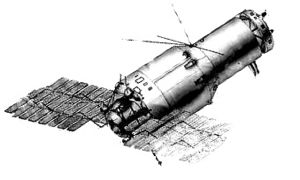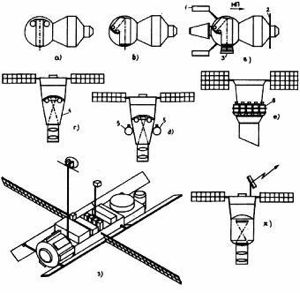
Home - Search - Browse - Alphabetic Index: 0- 1- 2- 3- 4- 5- 6- 7- 8- 9
A- B- C- D- E- F- G- H- I- J- K- L- M- N- O- P- Q- R- S- T- U- V- W- X- Y- Z
Russia

Vostok Moscow 1981
Credit: © Mark Wade
The true history of Soviet spaceflight is predominantly the story of Soviet military space. Manned or scientific space missions could often only be justified as part of larger military projects. Less than 20% of Soviet launches were for 'national prestige' purposes (civilian manned flights, scientific and planetary).
The Soviet Union was a planned economy, and space projects were developed in co-ordination with Soviet five year plans. Long range military forces plans were made for a ten year period, and implemented in two five-year phases. The first such plan was approved in 1961. The second was approved in 1970, but the failure of the N1 launcher project and the poor reliability of first generation Soviet systems led to a drastically revised ten-year plan for second generation systems being approved in 1976. The final long-range space plan, for third generation systems, was approved in 1981 but again drastically revised in the face of the American 'Star Wars' programmer in 1985. This was subject to constant alteration under Gorbachev and finally was never implemented. Following the dissolution of the Soviet Union the Russian Federation conducted space operations at a reduced level basically using assets and systems that were 'in the pipeline' before the end of the Communist government.
Russian space historians variously refer to three or four generations of space systems, resulting in some confusion. The planning process resulted in a cycle where development of new space systems was authorized in one five-year plan, followed by operational use in the next five-year plan. This resulted in Soviet space systems falling into three generations before the fall of the Soviet Union. Prior to these three generations a few projects were begun on the initiative of the rocket and spacecraft Chief Designers, before the military fully accepted or understood the usefulness of space systems.
- Era of the Chief Designers (1950 to 1960) - The first concrete studies for spacecraft and launch vehicles were initiated in 1956. Three projects were authorized for development: the ISZ first earth satellite (launched as Sputnik-3); the Zenit photo-reconnaissance satellite; and the Vostok first manned spacecraft. After the propaganda success of the first Sputnik in 1957, Korolev was authorized to develop the rockets and satellites necessary for the first probes of the Moon, Mars, and Venus. At the end of this period other design bureaus emerged as competitors to Korolev in the production of space launchers and spacecraft (Yangel, Chelomei). Their collective ambitious plans - for manned expeditions to the moon and Mars, for space battle stations and combat spacecraft in earth orbit, for a huge array of launch vehicles and satellites - were authorized on a study basis in 1960. At the beginning of the 1960's an unwieldy total of thirty space systems were in development. But the military soon asserted control to the situation and only a fraction of these projects reached the hardware stage.
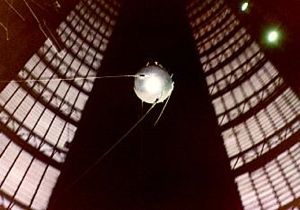
Sputnik 1
Credit: © Mark Wade - First Generation Soviet Space Systems - (1960 to 1975) - A July 1960 declaration defined the military systems to be developed in 1966 to 1970. Military research programs of 1962 to 1964 code-named Shchit (space systems), Osnova (space equipment), and Ediniy KIK (ground systems) defined the first generation of Soviet operational space systems, deployed in 1966-1975. First generation systems were often prototyped by Korolev or Chelomei, then spun off to new design bureaus for production. Many first generation systems did not reach full operational status but served as prototype and test articles for second generation operational systems.
- Mature First Generation Soviet Space Systems - (1970 to 1985) A Defense Ministry directive of 6 November 1968 laid out the actions to be taken in the late 1960's and early 1970's for unit programming for military utilization (Plans Mars, Osnova, Orion). The objective was to integrate space forces into overall military planning, taking into account the most cost-effective use of resources. Methodical operations planning was completed in 1970 with Plans Prognoz and Sirius Phase I. Development of the first nine systems of the second generation was completed in 1974-1975 and flight trials were conducted in the second half of the 1970's. The second group of second generation systems were developed in the second half of the 1970's and deployed in the first half of the 1980's. From 1971-1976 14 new space systems entered military service, and 16 were in operation.
- Second Generation Soviet Space Systems - (1975 to 1985) In April 1972 work began to draft a five-year plan for satellites to be used in the 1985-1990 period. These included Plans Sirius Phase 2, Dal', Gamma, Zamysel, Fon, etc. The final result was two plans: "Program for Military Space Units for 1976 to 1985" and "Basis or Direction of Development of Space Units through 1990". These plans, after evaluation by the Ministry of Defense, were approved by the Central Committee and Soviet Ministers on 27 February 1976. Second generation systems were to use a new series of modular spacecraft buses and ultimately a new series of launch vehicles. Satellite constellations were grouped into integrated systems to achieve specific military purposes. The satellites were normally modular designs developed in two phases - a phase 1 version that could be launched by an existing launch vehicles, and a larger phase 2 design sized for launch by the Zenit-2 booster. There was already considerable controversy as the 'Young Turks' took on the conservatives. Flight test and deployment of second generation systems were severely delayed, first by problems with the first stage of the Zenit-2 launch vehicle, then by diversion of resources to Third Generation 'Star Wars' systems.
- Third Generation Soviet Space Systems - (1985 to 1990) Third generation Soviet space systems constituted an integrated Multi-Element Space System, including the planned Multi-echelon Anti-Ballistic Missile System. Preparatory work for third generation systems was undertaken under the Tenth Five Year Plan (1976-1980), with full definition of the systems in the 11th Five Year Plan, (1981-1985). In 1985 the plans were drastically revised and a crash programmer was undertaken to meet the American Strategic Defense Initiative challenge during the 12th Five Year Plan (1986-1990). Third generations systems were to be fully on line by 1990. This plan was not achievable and the Soviet Union disintegrated before any third generations systems could be placed in service.

Sputnik 3
Credit: © Mark Wade - Russian Federation Space Systems - Post-Soviet Space - After 1991 - the break-up of the Soviet Union resulted in the launch site for the largest launch vehicles and the main planned launch vehicle producer being outside of Russia. The sudden collapse of the launch rate meant that sufficient launch vehicles and spacecraft had been built to continue operations at a much-reduced level. By the year 2000 work had begun on the new Angara 1.1 launch vehicle that would allow operations from Russian territory and using only Russian suppliers.
- Soviet Space System Development Process - This perhaps should be read this first to understand some of the terminology.
- Soviet Space Quality Assurance
- Soviet Space Tracking Systems
- See also Soviet Cosmodrome Histories:
- Baikonur
- Plesetsk
- Kaputsin Yar - Vladimirovka
- Svobodniy
The Era of the Chief Designers
Korolev works for Tass, Chelomei works on crap, Yangel works for us
- Soviet space forces aphorism, ca. 1965.
The theoretical and ideological basis for spaceflight in Russia - were established by Tsiolkovskiy. Between 1883 and 1932 he worked out the basic theoretical concepts of rocketry and space flight. His visions of man leaving the earth and colonizing space became a kind of space ideology that inspired and guided Soviet rocket engineers and space scientists. There was no real comparable ideological underpinning in the West.
Tsiolkovskiy's work led groups of enthusiasts to begin work on basic rocket technology. These young engineers - among them Korolev in Moscow, Glushko in Leningrad, and Tikhonravov - would become the chief designers who led the Soviet Union into space. Many of these talents were caught up in Stalinist purges in 1937-1938 and ended up in work camps in Siberia. Wartime necessity drove Stalin to bring the survivors back into 'sharashkas' - prison engineering design bureaus. Soviet military rocket research during World War II concentrated mainly on Jet-Assisted Take-off (JATO) units for combat aircraft and the RP-318, BI-1, and Malyutka rocket interceptors. Only toward the end of the war was work begun on long range rockets (Tikhonravov MK 4-stage rocket and Korolev's D-1 and D-2).
The huge German technical advances in rocketry during the war rendered this indigenous work obsolete. Stalin was determined to leapfrog the West by assimilating this new technology as quickly as possible. A decree of 13 March 1946 set up a number of research institutes to exploit the technology, and several thousand Germans were brought to Russia for this purpose. Young engineers were named to head the institutes, and more future chief space designers - Keldysh, Isayev, Chelomei, Reshetnev - began work on rocket technology. Keldysh pursued one of Stalin's pet projects - the Keldysh Bomber, an intercontinental rocket based on the German Saenger spaceplane design. This work eventually lead to the Buran - M-42 - M-44 and Burya intercontinental cruise missiles, but was a dead end as far as spaceflight was concerned. Similarly, tests were conducted with rocket-powered aircraft (LL, I-270, Samolyot 5, 346) but these did not lead to operational air or spacecraft.
Tikhonravov wrote a seminal paper on 15 March 1950 on the potential uses of artificial satellites. A decree of 26 May 1954 ordered preliminary studies of such systems. The technological basis was the N-3 project, which covered various engine and propulsion approaches. In August 1955 a unit was formed by Korolev to co-ordinate with Tikhonravov development of the first artificial satellite, for launch by the R-7 8K71 ICBM.
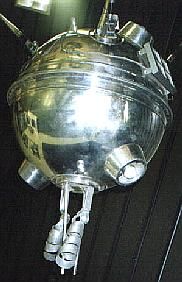 | Luna 1 / E-1 Credit: NASA |
-
Orbiting of satellites of 1.8 to 2.5 metric tons mass by 1958. This first artificial earth satellite (ISZ) was intended to be a physics laboratory that would characterize the space environment for design of future spacecraft. In July 1956 Tikhonravov completed the ISZ draft project. The go-ahead to build the spacecraft and the necessary KIK tracking system came in a decree of 3 September 1956. In the event, Tikhonravov's ISZ was not ready in time to beat the Americans into orbit, and small substitute satellites (Sputnik 1 and Sputnik 2) were hurriedly built to make the Soviet Union first in orbit. The ISZ was finally launched in 1958 as Sputnik 3.
- Unmanned reconnaissance satellite by 1970. Following the decree work began on a satellite for military reconnaissance, and throughout the year 1956 the Ministry of Defense issued a series of specifications for satellite maneuvering, orientation, control, photographic, and ELINT systems. A decree in August 1956 authorized design of a military reconnaissance satellite (code named Zenit).
- One week flight of a manned spacecraft by 1964. In the spring of 1957 Tikhonravov began study of manned spacecraft. By April 1958 the preliminary design was completed, essentially the Vostok 3KA spacecraft that would put the first human being into space. The effort spent on this was at the expense of work underway on the Zenit reconnaissance satellite. After the success of Sputnik, Korolev advocated that manned spaceflight should have first priority. After bitter disputes with the military, a compromise solution was reached. Korolev was authorized to proceed with development of a spacecraft to achieve manned flights at the earliest possible date. However the design would be such that the same spacecraft could be used to fulfil the military's unmanned photo reconnaissance satellite requirement. In November 1958 the Council of Chief designers approved the combined Zenit-Vostok program. The official decree to begin development of the Vostok was issued only on 22 May 1959. This was followed by a decree of 25 May 1959 that authorized development of the Zenit-2 and Zenit-4 reconnaissance satellites based on the Vostok design.
In parallel with the ballistic capsule Vostok approach, the Myasishchev and Tsybin aeronautical design bureaus worked on designs for a manned spaceplane. This work began in 1957 and culminated in competing draft projects for the Tsybin PKA and Myasishchev M-48, VKA Myasishchev 1957, VKA-23 Design 1 and VKA-23 Design 2 in 1957-1960. These were found to be beyond the immediately-available technology and never reached the hardware stage.
- Rocket capable of 12 metric ton escape velocity payload by 1970. This was pursued to the draft project stage as the nuclear powered Yakhr-2. Work on this was abandoned in 1959.
- Rocket with 100 metric ton low earth orbit payload, capable of placing 2 to 3 men on the moon- no date set. This requirement was to be fulfilled by the nuclear powered Superraket, abandoned in 1959 in favor of the conventional propulsion N1.
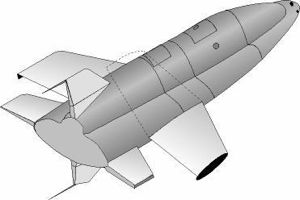 | PKA Isometric PKA Isometric drawing Credit: © Mark Wade |
Sputnik-1's launch on October 4, 1957 caused a tremendous sensation throughout the world and marked the beginning of the space race. The casual plan of 1956 was accelerated, and Korolev was authorized to develop new upper stages for the R-7 that would allow launches of unmanned probes to the moon and planets.
Korolev was not only in competition with the Americans, but other Soviet Chief Designers who wanted a 'piece of the action' in the space race. Korolev's chief rival was Chelomei, a designer of naval cruise missiles. It was apparent that the ballistic missile was superior to the cruise missile as a weapon system at intercontinental ranges and also would allow the exploration and colonization of space. Chelomei hired Nikita Khrushchev's son on March 8, 1958. This gave Chelomei sudden and immediate access to the highest possible patron in the hierarchy. He was rewarded with his own design bureau, OKB-52, in 1959. In this period Khrushchev was pursuing a major cutback of the military and consolidation of the defense industry. As part of this the Myasishchev and Tsybin aeronautical design bureaus were closed and the staff ended up being included Chelomei's organization.
Chelomei's cruise missiles were designed for long-term storage in environmentally-controlled capsules. Chelomei saw that this technology could be applied to ballistic missiles and spacecraft as well. A whole family of unmanned spacecraft, dubbed Kosmoplans and Raketoplans, would be built using modular elements. The spacecraft would be launched by Chelomei's equally modular family of UR universal rockets, capable of both ICBM and space launch missions. The UR-200 would be used for launch of smaller earth orbital Kosmoplans, and the UR-500 Proton 8K82 would be used for launch of manned, lunar landing, and interplanetary Kosmoplan - Raketoplan designs.
In 1959, as Chelomei laid out these plans, he knew a tremendous struggle would be required to wrest any part of the space programmer from Korolev. Korolev was interested in military projects only so far as they provided financing for his dreams of space exploration. He jealously wished to keep all manned, lunar, and planetary space projects to himself. In a letter to the Central Committee of the Communist Part in January 1960 he proposed an aggressive program for Communist conquest of space. He declared:
- That the design bureaus of the Soviet Union must make a broad swift assault on space research
- That a new rocket of 1,000 to 2,000 metric ton gross lift-off mass with a 60 to 80 metric ton payload must be developed at the earliest possible date
- That advanced propulsion systems - nuclear, Lox-LH2, low thrust liquid, ion, and plasma engines and correction rockets - be developed as quickly as possible
- That new automatic and radio guidance systems be developed to support these objectives
As payloads for this enormous rocket, Korolev proposed the following spacecraft be developed for launch in the period 1963 to 1965:
- Geostationary communications satellites of 2 to 3 metric tons mass for global communications
- Heavy OS manned space stations (25 to 70 metric tons) with a crew of 3 to 5, orbited at 350 to 400 km altitude. The station would conduct military reconnaissance, control other spacecraft in orbit, and undertake basic space research.
- Heliocentric satellite for solar studies of 1 to 2 metric tons mass
- Spacecraft with 2 to 3 men for flyby of the moon, entry into lunar orbit (L4-1960), and return to earth.
- MK interplanetary spacecraft with 2 to 3 crew on 2 to 3 year flyby missions to Mars and Venus. Automatic probes would be landed on the planets during the flyby maneuvers.
- Group flight of eight crew aboard four 30 metric ton spacecraft on expeditions to land on Mars and Venus. Crew per spacecraft would be 2 to 3.
- Global rockets that could bombard any point on earth with showers of nuclear warheads totaling 40 to 100 metric tons mass at ranges of 3,000 to 12,000 km
- Potential to establish a defensive space infrastructure that would annihilate any enemy satellites or rockets that flew over the territory of the USSR
- Photographic and electronic reconnaissance of every part of the earth
- Precision military navigation
 | VKA-23 1959 design Credit: © Mark Wade |
For his part, Korolev and the other chief designers would pledge to support this overall effort by the development of draft projects and fundamental research work to validate and mature the necessary technologies. They would place before the Central Committee in the third quarter of 1960 comprehensive plans for development of the new projects. It was requested that that the Central Committee authorize the design bureaus to undertake these draft projects, and that the Ministry of Finance be directed to allow the bureaus to use reserve funds to finance the work.
This letter was followed by a meeting with Khruschchev on the subject on 3 March 1960. Korolev believed it would be truly possible with backing from the very top to have a large rocket in the USSR in a very short span of time. Unfortunately at the meeting Korolev made a slip of the tongue he would always regret, admitting that his plan had not been agreed among all of the Chief Designers. This resulted in Khrushchev throwing the matter back for a consensus plan.
By 30 May 1960 Korolev was back with a plan that now included participation of his rivals, Chelomei and Yangel. The military, however, had not been fully consulted or reached any final conclusions as to its needs. The consolidated plan was as follows:
Launch Vehicles
- R-7 - Four-stage version of R-7- (Korolev) - 300 metric ton gross lift-off mass, available from 1960 for robotic lunar and interplanetary flights (this would be the Molniya 8K78 booster). Removal of the fourth stage resulted in the Voskhod 11A57 launch vehicle used for launch of later, heavier Zenit and Vostok spacecraft.
- R-7L - (Korolev) - Develop in 1960 to 1962 a 4 stage version of the R-7, utilizing R-9 technology, with a 300 metric ton gross lift-off mass and high specific impulse engines in the last stage. Payload 10 metric tons to low earth orbit and 3 metric tons to escape. Draft project to be completed in 1961 (this booster, later called the Molniya 8K78L, was never developed).
- UR-500 - (Chelomei) - Develop a 600 metric ton gross lift-off mass rocket using new chemical propellants for sending spacecraft to nearby planets. Draft project to be completed in 1962. (This would become the UR-500 Proton booster)
- N-I - (Korolev) - to be developed in 1960 - 1962. Booster with 40 to 50 metric tons payload to low earth orbit and 10 to 20 metric tons to Mars. Draft project to be completed by second quarter 1961.
- N-II - (Korolev) - to be completed in 1963 - 1967. Booster of 60 to 80 metric ton payload to low earth orbit and 20 to 40 metric tons to Mars. Draft project to be completed in 1962.
 | VKA-23 1960 design Credit: © Mark Wade |
- Vostok recoverable spacecraft (Korolev) :
- Photo and electronic reconnaissance versions to be developed in 1960 to 1962 (these would be the Zenit-2 reconnaissance satellites. They would end up flying after, not before, the Vostok manned flights)
- Manned version to be developed in 1961 to 1963 (these flew on schedule)
- Scientific research version to be developed in 1960 to 1962 (these were designed but never flown)
- Maneuverable rendezvous and docking version to be developed in 1961 to 1963 (this was the Vostok-Zh - never flown, replaced by Soyuz)
- KS - (Korolev) - Heavy manned spacecraft, 2-3 crew, to demonstrate rendezvous, docking, and controlled flight. To be developed in 1961 to 1963 (this would become Soyuz A).
- KL - (Korolev) - Manned spacecraft for lunar flyby. To be developed in 1961 to 1964 (this would go through may design iterations and political intrigues - ranging from the L1-1960, L1-1962, to the Soyuz A. However Chelomei would be assigned the project (LK-1), only to have Korolev get it back in 1965 and finally reach flight status as the Soyuz 7K-L1). Korolev also studied lunar automatic crawlers (L2-1963), manned lunar landers (L3-1963), manned lunar orbiters (L4-1963), and manned lunar crawlers (L5-1963). The Lunar L3 lander project was authorized in 1964 and the L2 emerged as the Luna Ye-8 Lunokhod.
- KMV - (Korolev) - Interplanetary manned spacecraft for 2-3 crew, flyby of Mars and Venus. To be developed in 1962 to 1965 (this was the TMK-1. This design would evolve into full-blown Mars landing expeditions during the course of the 1960's ( TMK-E, Mavr, KK).
Scientific and Planetary Spacecraft
- M - (Korolev) - Launch of Mars 1M robot probes in September - October 1960 and 2MV probes in 1962 (these Mars flights were attempted on this schedule). These used the three stage Luna 8K72 version of the R-7 authorized in 1959.
- V - (Korolev) - Launch of Venera 1VA probes in January 1961 and 2MV probes in 1962 (these Venus flights were attempted on this schedule). These used the three stage Luna 8K72 rocket.
- E - (Korolev) - Launch to the moon (as per the decree of 10 December 1959) of Luna E-1 - Luna E-1A impactor probes in 1960 to 1961 and Luna E-3 orbiters in 1961. These used the three stage Luna 8K72 rocket. They were followed by heavier Luna E-6 lunar soft landers launched by the Molniya 8K78 booster.
- K - (Chelomei) - Development of unpiloted Kosmoplans for flight to Mars and Venus with return to earth and landing at conventional airfields. These would use new exotic chemical systems, low thrust nuclear engines (nuclear-plasma, ion, atomic hydrogen). Sub-variants with a total mass of 10 to 12 metric tons and 25 metric tons would be developed in 1965-1966. Draft project to be completed in 1962.
- Elektron - (Korolev) - high apogee radiation belt research Elektron-A and Elektron-B satellites, developed according to decree of 10 December 1959, to be launched in 1960 to 1961 (these flew late to schedule)
Military Spacecraft
- US-A - (Chelomei) - Naval reconnaissance satellite using P6 nuclear reactor. Derivative of the Kosmoplan to be developed in 1962 to 1964 (these flew late to schedule)
- R - (Chelomei) - Manned Raketoplan spacecraft for orbital maneuvering flight and recovery at conventional airfields. Total mass to be 10 to 12 metric tons, total gliding range during re-entry 2,500 to 3,000 km. Unpiloted version to be developed in 1960 to 1961, followed by piloted version in 1963 to 1965. Satellite interceptor operational version to be tested in 1962 to 1964 (only suborbital subscale tests were conducted on this program before it would be cancelled. One variant became the LK-1 manned circumlunar craft, cancelled in turn before it flew)

Vostok 1KP
Vostok 1KP Energia Museum
Credit: © Mark Wade- Communications satellites - (Korolev) - R-7 launched satellites to be developed in 1961 to 1963 (these would fly, behind schedule, as the Molniya-1 series), to be followed by heavy rocket satellites in 1962 to 1964 (designer not decided).
- DS - Small satellites - launchers - (Yangel) to be developed in 1961 to 1965, together with the Kosmos-2 and Kosmos-3 launch vehicles derived from the R-12 and R-14 ballistic missiles (this program flew on schedule - early flight tests included 1MS - 2MS prototypes from another design bureau).
- OS - (Korolev) - Space stations - the Ministry of Defense was to decide by the fourth quarter of 1960 whether it can utilize military stations with multiple independent rocket-warheads. This design was iterated through many versions - TKS Heavy Space Station, OP, OS-1 (1965), OS-1 (1969) into the MKBS space station during the course of the 1960's. The cancellation of the N1 in 1974 would finally kill further work on large space stations in Russia until later versions of Mir-2 in the mid-1980's.
- IS - Antisatellites - the Ministry of Defense was to decide by July 1960 whether to develop an R-7 launched system for annihilation of enemy reconnaissance satellites (this project was conducted, but given to Chelomei for launch on the UR-200. Eventually flew in the late 1960's, as the IS-A, launched by Yangel Tsyklon 2 rockets)
- Military Communications Satellites - the Ministry of Defense was to decide by the fourth quarter of 1960 whether to proceed with development of military communications satellites (this was done - the Strela-1M and Strela-2 series).
The final government decree 715-296 of 23 June 1960 'On the Production of Various Launch Vehicles, Satellites, Spacecraft for the Military Space Forces in 1960-1967', authorized draft project work to begin on this massive agenda.
Meanwhile the projects authorized in the 1950's were underway, maintaining the Soviet lead in the space race. In January 1960 Star City, the Cosmonaut Training Centre, was founded by the Soviet Air Force and Kamanin was made the head. The first cosmonaut candidates arrived in March 1960. Following unmanned flight tests of Vostok 1KP, Vostok 1K and Vostok 3KA configurations, Yuri Gagarin made the first manned space flight on 12 April 1961. Five further manned Vostok flights maintained the Soviet lead in the space race. In order to keep up with the Americans, Korolev developed and flew a multi-crew version of Vostok (the Voskhod 3KV) and a Vostok with an airlock to accomplish the first spacewalk (the Voskhod 3KD). Further Vostok and Voskhod flights (such as the Voskhod 3KV Tether experiment) were planned but cancelled in order to concentrate on the more capable Soyuz spacecraft.
In parallel with Vostok the more sophisticated Zenit-2 and Zenit-4 photo-reconnaissance variants of the spacecraft reached service. Zenit-2 flights began in December 1961; 13 were flown in two years. The system was accepted into the military service in 1964. Zenit-4, the high resolution version, followed in 1965.
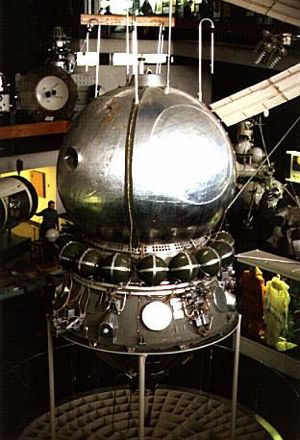 | Vostok spacecraft Vostok spacecraft view 1 Credit: © Mark Wade |
The Soviet military realized that having the Chief Designers define space systems was a 'bottom up' approach that did not address the country's real needs. They were faced with an immense American build-up of ballistic missiles which they could not hope to match if resources were squandered on grandiose space projects. Therefore measures were taken to obtain control of the situation.
A July 1960 declaration listed the military systems to be developed in 1966 to 1970. Military research programs of 1962 to 1964 code-named Shchit (space systems), Osnova (space equipment), and Ediniy KIK (ground systems) defined the first generation of Soviet operational space systems, deployed in 1966-1975. First generation systems were often developed by Korolev, then spun off to other design bureaus for production. At the beginning of the 1960's an unwieldy total of thirty space systems were in development.
In the early 1960's Russian strategic nuclear forces on land, sea, and air were already in place. The military wished to integrate military space forces with these in a systematic manner as soon as possible. These requirements resulted in definition of an SKV - Space Military System. The SKV would exploit the global range of orbital systems; determine the precise location of mobile and fixed targets for strike by strategic forces, precisely hit such targets, and quickly and securely transmit targeting information.
A hallmark of the early 1960's was militarization of space under the shadow of Kennedy's policy of massive retaliation. Both the US and USSR deployed unmanned and developed manned systems to identify, track, and destroy the enemy's satellites. ABM systems could also be used to hit satellites in orbits up to 200 km. This process of militarization of space was only averted, in the Soviet view, by actions taken by Nixon in the 1970's (the SALT-I treaty, the ABM treaty, and secret understandings to stop development of anti-satellite systems).
The period 1966-1970 featured the first practical use of space systems of the first generation.
First generation satellites were very unreliable. One problem was unrealistic specifications, another a lack of proven space-worthy components. The first solution was redundant systems, and these were tried on an experimental basis in the Meteor, Strela, and Tsiklon satellites. Flight demonstrations proved use of better construction methods would allow guaranteed satellite lifetimes of two to three years. Meanwhile the operational situation reached a crisis point. The USA had faced the same problem, and developed a strong reliable component basis for spacecraft. This had increased individual American satellite lifetimes to 3 to 5 years and system operational lives to 5 to 7 years (through use of on-orbit reserve spacecraft). But in the Soviet Union, due to the urgency to deploy, there was no time to develop such a technical basis for first generation systems. Only in the 1970's were reliability problems solved through use of qualified standard components, standard means of documentation, and quality assurance.
While the reliability of first generation systems was poor, they still met the needs of the Rocket Forces and General Staff. Quick reaction (10 to 12 day) launch times were achieved, and the new systems allowed precise targeting of long range rockets and naval forces. The Korund space communications system provided reliable command and control of the strategic forces.
Military space operations began in 1961 with the 'Provisional Rocket-Engineering Auxiliary' VNIRS-61. This initially developed military operational plans for launch sites and command and control activities, including regularly scheduled maintenance operations. This first phase, which prepared the military to execute space operations and conduct trials of systems, was completed by 1965. The first military space operations plans were prepared for the Zenit reconnaissance satellite system in 1964 to 1965, and subsequently used by the General Staff in the operation of that system.
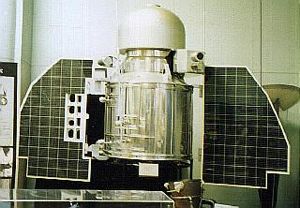 | Venera 1 Credit: NASA |
Target Identification and Location
- Photo reconnaissance - cartography: While Korolev had designed the first such satellite, the Zenit-2, detailed design of the Zenit-4 high-resolution model and production of all follow-on spacecraft was handled by Kozlov. In mid-1967 plans were approved for further development of these models through 1975, taking into account work then underway. The results were the improved Zenit 2M and Zenit 4M satellites, taken into military service in 1970 and 1971.
- Yantar follow-on reconnaissance satellite: Originally Yangel was to handle Yantar, but his design bureau was too busy building higher-priority ICBM's for the RSVN Rocket Forces. So Kozlov took up the project in 1969. Yantar-1KF and Yantar-2K test-construction work began in 1970, but the new series of satellites would be completed only as second and third generations systems.
- Manned Photo-reconnaissance: Draft projects for two such designs, Kozlov's Soyuz-R and Chelomei's Almaz APOS, were authorized in 1964. Soyuz-R was cancelled when it became too heavy for the planned launch vehicle. The Almaz, a dedicated platform for manned high-resolution multispectral study of specific targets, continued. The flight trials were intended to prove the effectiveness of manned orbital reconnaissance operations. The program was to take place in two phases. Phase 1 would man the space station using crews shuttled by Korolev's Soyuz 7K-T-A9 spacecraft. Phase 2 would be the operational system, serviced by Chelomei's much larger TKS manned resupply spacecraft. The program was delayed for two years when Almaz hulls were diverted for the Salyut 1 DOS crash programmer to launch a space station before the American Skylab. Finally the first Almaz was launched in April 1973. It depressurized and was abandoned before a crew could be launched. Salyut 3 in 1974 and Salyut 5 in 1975 to 1976 were successfully manned. But the results of the flights showed that manned reconnaissance was not worth the expense. There was minimal time to operate the equipment after the crew took the necessary time for maintenance of station housekeeping and environmental control systems.
- ELINT (Electronic and Signals Intelligence): An initial capability was provided by the Zenit-2, which carried the Kust ELINT apparatus. From 1965 to 1967 two dedicated ELINT systems were tested: the Tselina and the Navy's US. Both reached service, since the Ministry of Defense could not force a single system on the military services.
Tselina was developed by Yuzhnoye and consisted of two satellites: Tselina-O for general observations and Tselina-D for detailed observations. ELINT systems for Tselina were first tested under the Cosmos designation in 1962 to 1965. The first Tselina-O was launched in 1970. The Tselina-D took a long time to enter service due to delays in payload development and weight growth.
The Navy's US radio intelligence satellites were built in US-P (passive detection) and US-A (nuclear powered active radar) variants. Development was begun in 1960. They were descended from Chelomei's Kosmoplan modular spacecraft design, and were part of an integrated naval war-fighting system, feeding locations of enemy naval forces to Chelomei-built ship-launched cruise missiles. Both satellites were designed for launch by Chelomei's UR-200 rocket. On October 13, 1964, Khrushchev, Chelomei's patron, was ousted from power. The new leadership decided to assign the US project to Savin, with Chelomei in the sub-contractor role, to be launched by Yuzhnoye's Tsiklon-2 rocket. Delays resulted in the US being implemented as a second generation systems in the 1970's.
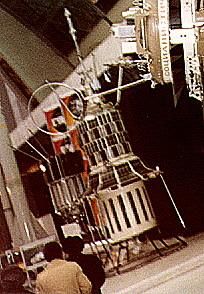
Elektron-B
Credit: © Mark Wade - Television reconnaissance: Chelomei began project work in 1963 on the Space Television Reconnaissance System (TGR). Savin had developed the original concept. But it was found that the technology did not yet exist for even a draft project to be completed. The concept would not enter operation until the Yantar series in the 1980's.
- Navigation: Tsiklon, the first Soviet navigation satellite system, was designed by Reshetnev. Experimental flights began in 1967 in order to develop a system meeting the required tactical and operational characteristics. The Tsiklon-B operational system provided not only navigation information but also store-dump radio communications for Soviet naval forces. The system was accepted into military service in 1976.
- Meteorology: The Meteor satellites were developed as per a decree of 30 October 1960. Work began in 1961 at Yuzhnoye; in 1962 it was transferred to VNIIEM. Final development was completed in 1964. The system went into operation in 1969.
- Geodesy: Reshetnev's Sfera geodetic spacecraft allowed measurement of geodetic points leading to improved accuracy of long range weapons. Flight tests were from 1968 to 1972, and operational flights were from 1973 to 1980. The Kosmos 3M launcher was used.
- Strategic Communications: The strategic communications requirement was met by the Molniya-1, developed by Korolev. This used an elliptical 12 hour orbit that could be reached by existing launch vehicles and was better suited than geosynchronous orbit for communication with polar areas of the Soviet Union. The experimental version of the spacecraft proved so successful that it was put into service. Reshetnev was responsible for production and follow-on models. The entire system, designated Korund, using existing Gorizont military tropospheric communication ground stations, went into partial operation in 1968. The Molniya-2 model was developed to accommodate the Orbita television system, and was operational by 1972. The Ruchey Command and Control System communications stations for the Rocket Forces, Air Force, and Navy were completely in place by 1975. Korund allowed strategic communications and telephony with military units in Siberia and the Far East. The system finally included 8 spacecraft, replaced at increasing intervals as reliability improved over the 20 year life of the system.
- Tactical Communications: Reshetnev's Strela medium earth-orbit store-dump survivable communications system was developed experimentally in the 1960's, with flight tests from 1964 to 1965. Production system flight tests began in 1970. In 1973 and 1974 the Strela 1M and Strela 2M systems were accepted by the military. This system proved the basic concepts used in the Iridium and Globalstar commercial satellite constellations decades later.
- Fractional Orbital Bombing System (OGCh): In the early 1960's the Soviet planners pursued the concept of a 'global rocket' - a missile that would place nuclear warheads into low earth orbit, where they could approach the enemy from any direction, under the existing ballistic missile detection radars, and strike with little warning. Competitors for the single-warhead GR-1 requirement were Chelomei's UR-200, Korolev's GR-1, and Yangels' R-36-O. Only Yangel's design went into production and was in service until 1992. For the GR-2 multiple warhead requirement Yangel's R-56 and Korolev's N-11GR - N-11 1963 designs were rejected in favor of Chelomei's Proton 8K82. The Chelomei design was tested but never went into service. American development of orbiting infrared warning systems that could detect missiles on launch negated the surprise attack element at the core of the concept.
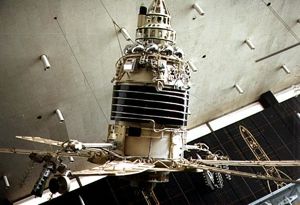
Molniya-1
Credit: © Mark Wade - Anti-Satellite: The original IS anti-satellite design was to be a Kosmoplan built by Chelomei and launched by his UR-200 booster. It was tested by him as Polyot. After the fall of Khrushchev the satellite project was handed to Savin with the launcher changed to Yuzhnoye's Tsyklon 2. The first test series of the IS-A ASAT was conducted in 1968-1972 using two different targets ( IS-P, DS-P1-M). These tests were wholly inconclusive, and a second test series in 1972-1975 was necessary to complete the state trials. The system was finally accepted into military service in February 1973 as the IS system. In connection with the 1972 Strategic Arms Limitation Treaty further operational trials were discontinued.
- Training-target objects: These were designed by Kovtunenko at Yuzhnoye as part of the 'DS' light satellite series and first tested under the Cosmos designation in 1962 to 1965. The DS-P1-Yu and DS-P1-I spacecraft were for radar tests of the PVO Air Defense and ABM systems. They were accepted into the military in 1968 and 1970 as the 'Raduga' complex and remained in service until 1978. The DS-P1-M 'Lira' target for PKO Antisatellite Forces systems was designed for both anti-ballistic missile and anti-satellite testing. It was more than a passive target, including an impact registration system that returned data on the elements of the hit (direction, velocity, etc.). First flight trials began in August 1970 and the target was in service from 1973 to 1983.
- Manned combat spacecraft: An initial draft project for the Soyuz-P manned interceptor was approved in 1964. Studies showed the complexity and danger of such an approach. But American military experiments aboard Gemini flights and pursuit of the military Manned Orbiting Laboratory (MOL) lead to work being resumed on a crash program of a new design in 1965. This Soyuz VI was to conduct space military research not covered by Almaz - manned earth observation, orbital inspection and destruction of enemy satellites. Soyuz VI was supposed to fly quickly, but fell victim to defects in the basic Soyuz design and internal politics at Korolev's design bureau. By 1970 the American MOL had been cancelled and Soviet flight tests had provided convincing evidence that near-earth manned operations were better suited to solution of national economic problems than military ones. So Soyuz VI was cancelled.
- Manned Spaceplane: Chelomei's Raketoplan manned spaceplane interceptor was cancelled in 1965 and replaced by the Mikoyan Spiral OS. This reached flight test status (MiG 105-11 and BOR-4) in the 1970's before being replaced by the Buran space shuttle.
Monitoring- Characterization of Near-Earth Space: Two Energia spacecraft, adapted from the Zenit reconnaissance satellite, were launched in the 1970's to study high-energy cosmic rays. These were supplemented by the Lavochkin Prognoz series, launched in 1972 to 1976, for study of geomagnetic fields, radiation, and solar physics. They continued the work of the Elektron-A and Elektron-B spacecraft of 1964.
 | Soyuz PPK Soyuz PPK antisatellite interceptor (conceptual drawing based on description). Credit: © Mark Wade |
Systems tests and scientific experiments: From 1968 Nauka attached containers or free-flying sub-satellites were used on Zenit reconnaissance satellites to develop methods to study radiation belts; establish radiation standards; establish the characteristics of the earth-space interface; and develop new instruments. 23 autonomous sub-satellites conducted methodical research into geophysics, meteorology, and cosmic rays. The DS series of light satellites developed by Yangel also provided platforms for a wide range of technology equipment tests and space environment monitoring. They flew under the 'Cosmos' satellite program ('Cosmos' name was also used as the cover name for any military satellite or launch failure). This program was managed by the Third Directorate of the GURVO Rocket Forces, consisting of four sections of 36 officers and 5 civilians.
National Prestige Programs
Although they represented only 20% of launches, national prestige projects (manned and planetary missions) represented 50% of the effort of the military, which was responsible for the launch facilities and operations. This was due to their scale and use of non-standard launch vehicles and spacecraft.
- Manned Earth Orbit Rendezvous and Docking - Korolev obtained approval for development of the Soyuz 7K-OK in December 1963. The spacecraft was to prove out systems for automatic rendezvous and docking of spacecraft, extra-vehicular activity, and scientific research. The Soyuz had severe development problems during its first flight series from 1966 to 1970. The only completely successful missions were Soyuz 4-Soyuz 5 in January 1969 (first docking and crew transfer between two manned spacecraft) and Soyuz 9 in June 1970 (record 17 day mission). Versions were designed but never flown to test artificial-G in earth orbit ( Soyuz 7K-OK Tether) and to test the Kontakt docking system for the lunar landing program ( Soyuz Kontakt).
- Manned Lunar Projects - The Soviet government waited until 1964 before deciding to take on the 1961 American moon race challenge. The secret Russian program failed to beat the Americans to a landing on the moon. There were three parallel projects: the Lunar L1 (LK-1) program, assigned to Chelomei, to beat the Americans to a circumlunar flight; the Lunar L3 (Soyuz 7K-LOK - LK) program, assigned to Korolev, to land a Soviet man on the moon; and the Zvezda permanent lunar base (built from DLB Modules), assigned to Barmin. The key element of the last two projects was the N1 launch vehicle.
It was decided in the second half of 1965 that Chelomei would no longer be responsible for high-priority projects, and the L1 project was assigned to Korolev. A month later Korolev died suddenly, a crippling blow to the entire program. Mishin was named as Korolev's successor after a long delay.
Korolev's Soyuz 7K-L1 was flown in several versions to support the L1 and L3 projects (Soyuz 7K-L1P, Soyuz 7K-L1E, Soyuz 7K-L1A) but could not be qualified for manned flight before Apollo 8 orbited the moon and ended the first lap of the moon race. The first N1 launch was to be in 1967 but was delayed to 1969 due to serious deficiencies in organization and co-operation. Chelomei and Glushko advocated dumping the N1-L3 design and using their UR-700 - LK-700 for a direct lunar landing. These alternates were rejected, but the first two N1 launches, in January and July 1969, resulted in the explosion of the launch vehicle. In retrospect a fatal error was made in deciding to launch a vehicle of this size from the remote Baikonur cosmodrome. Since Korolev rejected modular designs, the vehicle could not be transported by rail or water to the selected launch site; it had to be built at the site itself. Budget limitations meant that the enormous first stage was not static tested before flight.
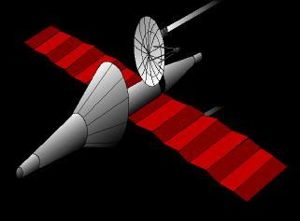
Kosmoplan - Mars
Kosmoplan - Mars reconnaissance version
Credit: © Mark Wade - Lunar probes: Babakin, at the Lavochkin bureau, had been assigned development of heavy unmanned probes to support manned lunar base construction. Ten of these Luna Ye-8 probes were launched from 1969 to 1974, and they successfully returned lunar soil to earth and roved the surface. The success of these probes allowed the Soviet Union to promulgate the myth that they had never been in the moon race.
- Planetary probes: The 2MV probes were replaced first by the 3MV series. To match ambitious American plans for robot exploration of Mars in the 1970's, the four-times-heavier 4MV bus was introduced, requiring launch by a Proton rocket. This continued to be used for Soviet planetary probes, and some heavy scientific satellites (Granat, Astron, Prognoz), to the end of the century. Soviet probes to Venus were generally successful. None of the six probes sent to Mars returned any significant data.
- Intercosmos and international programs - Launches of payloads developed by countries friendly to the Soviet Union aboard DS satellites from Yuzhnoye began in April 1967. Intercosmos-1, the first dedicated launch, came in October 1969. The last launch of the first generation of the series was in 1976. Launch of similar Soviet-French Oreol satellites, code named Arkad, were made in 1971 and 1973. The Soviet Union also assisted India in development of its Aryabhata satellite, launched by a Russian rocket in 1975.
- R-7 derivatives: The original R-7A 8K74 ICBM had been adapted on a crash basis in the late 1950's with addition of third and fourth stages. The design was productionized and standardized by Kozlov in the mid-1960's, using common elements between the configurations, resulting in the following versions: two stage Polyot 11A59, with single-engine third stage Vostok 8A92, with four-engine third stage Soyuz 11A511, and four stages Molniya 8K78.
- Light launch vehicle: To provide a more economical launcher than the R-7 , Yangel developed the Kosmos 63S1, using the R-12 IRBM as the first stage, with a 300 kg payload. It had a relatively poor record of 40 launches with 12 failures. It was replaced by the Kosmos-2-Kosmos 11K63, with a 450 kg payload. From 1966 to 1977, it had a record of 123 launches with 8 failures.
- Light medium launch vehicle: In 1961 Isayev and Reshetnev developed the two stage Kosmos-1 - Kosmos 65S3 - 'Voskhod' launch system on the basis of the Yangel R-14 IRBM. Test launches were conducted from 1965 from the R-16 ICBM Launch Complex 41 at Baikonur. The serial production version was the Kosmos-3 - Kosmos 11K65, built at the Krasnoryarsk Machine Factory. After further development at NPO Polyot, work on the modified Kosmos-3M - Kosmos 11K65M began in 1967. This added a restartable second stage with an orientation system. Flight trials from the Voskhod complex at Plesetsk began in 1967 and it was accepted into military service in December 1971. This booster was launched form two Cusovaya launch complexes from Plesetsk after 1987.
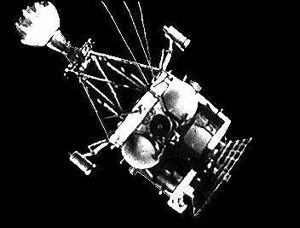
ASAT IS-A
Credit: Videokosmos - Medium Launch Vehicle: Chelomei flight tested his UR-200 booster for launch of IS and US satellites, but this was cancelled in 1965. In its place Yangel began development of a launch vehicle derived from his R-36 ICBM with an upper stage. This could put a 3 metric ton payload into low earth orbit and was designated Tsyklon-2. Launches began in Baikonur in 1969, and in February 1973 the Tsyklon-2 was accepted into service.
- Heavy Launch Vehicle: Chelomei had developed the Proton 8K82 as a super-ICBM from 1962. The three stage Proton 8K82K and four stage Proton 8K82K - 11S824 versions were developed from 1964 for the manned circumlunar flight program and for launch of heavy probes to Mars and Venus. The booster was not used by the military until 1978. Development was difficult due to the high degree of automation and numerous factory mistakes. Test launches of the boosters were used to orbit the heavy N-4 and N-6 physics satellites.
Mature First Generation Soviet Space Systems
Mature first generation space systems provided targeting and communications support for the Soviet strategic forces. These systems were developed in the Ninth Five Year Plan (1971-1975) and deployed in the Tenth Five Year Plan (1976-1980). However initial planning began in November 1966 when TsUKOS MO (Central Directorate of the Space Forces of the Ministry of Defense) formed the first permanent unit for military space operations with Col A I Udaltsov as its Chief. In the period 1966 to 1969 the unit prepared and put into operation formal technical procedures. These were issued in June 1969 in the manual, 'Organization, Maintenance, and Military Operation of Space Systems'.
Plans Epokha (1965), Koltso (1968), and Oblako (1970) formalized the military-political structures for space operations, and determined the optimal groupings of earth- and space-based forces in military operations. The theoretical plan Koltso (1966-1968) defined an organized method for scientific development of space forces and showed that they could be operated in fundamentally the same way as other arms of the military. In 1968 4 NII MO (Fourth Scientific Research Institute of the Ministry of Defense) formed Filial 4 for scientific research. In April 1970 two directorates were formed, one for Military Space Units Research and the other for Mathematical-Modelling Military Research. These consisted of five new science units, and 12 laboratories. They conducted ballistic calculations for the RVSN Rocket Forces and Space Forces and prepared the TTT and TTZ specifications for new projects.
A Defense Ministry directive of 6 November 1968 laid out the actions to be taken in the late 1960's and early 1970's for unit programming for military utilization (Plans Mars, Osnova, Orion). The objective was to integrate space forces into overall military planning, taking into account the most cost-effective use of resources. This included basic space research for military and national economy purposes.
Methodical operations planning was begun by Filial 4 NII MO from 1967, and was completed in 1970 with Plans Prognoz and Sirius Phase I. These established the development plans for the space forces in the period 1971-1980. These plans set the following objectives:
- Utilization of spacecraft constellations to carry out extremely complex operations in solving military, scientific, and national-economic problems;
- Production of new on-board systems of increased size, satellite buses of increased size and payload, improved radio technology and materials
- Three launch vehicles in place of ten
- Improved KIK tracking stations
- Increased survivability of the tracking network through dispersal of center operations to regional centers, using central co-ordination and planning, and use of mobile as well as stationary KIK points

Soyuz VI
Soyuz VI. Forward view showing Soyuz descent module located ahead of cylindrical orbital work compartment.
Sirius Phase I was the first space project based on recommendations of the Scientific-Technical Committee of the Rocket Forces, headed by General N N Alekseyev. This first project plan was include in the ninth Soviet Five Year Plan (1971-1975).
The Soviet military units responsible for space operations went through several reorganizations. From October 1964, the Third Directorate of the GURVO (Main Directorate of the Rocket Forces), was responsible for Baikonur and Plesetsk operations. From March 1970 GUKOS MO (Main Directorate of the Space Forces of the Military of Defense) was formed and took over this responsibility. It reported directly to the General Staff. GUKOS was able to wrest control of the MKRTs electronic surveillance system from the Russian Navy but ASAT and SPRN Early Warning Systems remained the responsibility of the PVO Air Defense Forces.
In 1971-1976 trials of all first generation systems were completed and the phase of implementation and full utilization of these systems began. Of the 30 systems authorized for draft project stage, only 14 systems entered service. Those eliminated included almost all of the elaborate manned military and space exploration designs of Korolev and Chelomei.
In 1970 to 1976 standard manuals and norms were developed for the operation of the space forces. Launch and tracking facilities became more standardized and steps were taken to make the space forces more resilient in combat. Measures taken included development of autonomously-operating satellites, orbiting of reserve satellites, and deployment of mobile reserve tracking stations. Systems were developed for operation in difficult conditions, including enemy jamming environments. Both ground stations and satellites were provided with the capability to maneuver whenever possible.
By the end of the 1970's space systems were in place that were integrated into the country's military doctrine and plans, fully supported Soviet strategic communications, and provided command and control of continental and oceanic military forces.
Development of the first nine systems of the first generation was completed in 1974-1975 and flight trials were conducted in the second half of the 1970's. The second group of first generation systems were developed in the second half of the 1970's and deployed in the first half of the 1980's. They provided crucial intelligence that helped maintain the USA-USSR balance of power.
First generation systems were designed for practical application of space technology by all parts of the state (military, economic, science, control, agricultural, international co-operation, etc.). These were a result of the following policy decisions:
- Space units were to be national systems, applicable to multiple solutions
- Development and realization of increased reliability and survivability of space systems, including use of anti-satellites of various types.
- Development of autonomous operating systems that best used the resources of the satellite, including digital computers for control, diagnostics, and guidance
- Common modular systems that could be used in all series of satellites (KAUR at Reshetnev's KBPM, AUOS at KB Yuzhnoye, Yantar at Kozlov's TsSKB, etc.)
- Highly effective control units.
- New launch vehicles, using automatic guidance systems, that could place a range of payloads in various orbits without redesign of the booster.
- New technologies; improved reliability, communications; digital devices in place of analogue; defined common systems.
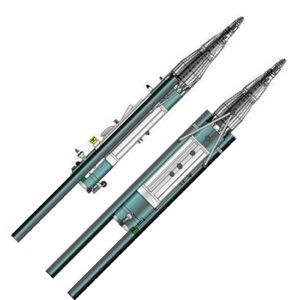
US-A
Credit: © Mark Wade
- Recognize preparations for an attack on the Soviet Union
- Strategic and tactical reconnaissance for land, sea, air, and space forces
- Identify attacking units
- Military-political communications with strategic and tactical units
- Navigation of military units
- Topographic and hydrographic support of the armed forces
- Control of forces during a nuclear strike and during preparation for retaliation
- Support exercise and test of military systems
- Space Reconnaissance Systems
- Zenit-4MK - Modernized high resolution version of the satellite that went into service in 1972.
- Zenit-4MKM - A further modification, entered service in 1978.
- Zenit-6U - A universal variant, used in two altitude ranges, for both observation and high resolution missions. Accepted for military service in 1978.
Photo-Reconnaissance: A series of new design reconnaissance satellites using the Yantar bus were intended to replace the Zenit series. The Yantar-2K featured double the duration and film capacity of earlier systems. This was combined with improved operational dissemination and use of information. Development work was started in 1971, flight tests began in 1974, and the Yantar-2K flew until 1983. However development of other members of the Yantar series was protracted and test of the Yantar-2K showed it did not have the resolution to provide strategic warning of attack. Therefore improved Zenit models filled the gap. The Zenit design was modernized 4 times by Kozlov in 1972, 1976, 1978, and 1983 with better photo apparatus and film. The final versions could maneuver in orbit and photograph small objects. These variants were:
- Ballistic Missile Early Warning System
- Work on the Oko satellite in Molniya-type elliptical orbits began in 1967 as the USK - space system to observe rocket launches. Using multi-spectral sensors they provided the Soviet Union with warning-on-launch of enemy ballistic missile attacks (15 to 30 minutes earlier than radar systems). Four experimental versions of the satellite were launched from 1972-1976, beginning with Kosmos 520. Three of these were put into operation, resulting in an initial useable system in 1977. But even with a four satellite constellation 24 hour observation of all possible enemy launch locations was not possible.
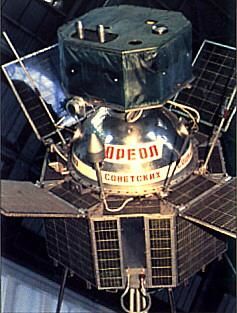
Oreol - MKRTs - Naval Space Reconnaissance and Targeting System
The Navy's US radio intelligence and targeting satellites were built in US-P (passive detection) and US-A (nuclear powered active radar) variants. The projects were moved from Chelomei to Savin at KB Arsenal in 1967. Launch vehicle was changed to Yuzhnoye's Tsiklon-2 rocket. Following a crash redevelopment programmer the US-P entered service in 1971 and the US-A in 1975.
- TGKS - Topographic - Geodetic Space System, operational 1976
- Zenit-4MT for topographical photography. Accepted into service in 1976.
- Zenit-8 for military cartography. Accepted into military service in 1983.
- Navigation Systems
-
The Tsikada updated first generation navigation system represented a collaboration between the Navy, Academy of Sciences, and Ministry of Shipping. The basis was the Tsiklon-B doppler navigation system, but Tsikada was designed for asynchronous operation of on-board equipment with only essential equipment receiving a timer interrupt. Development began in 1974 and flight trials began from Plesetsk in 1976. The launch of Kosmos 1000 on 31 March 1978 marked the beginning of deployment of the operational system. The system was accepted for military service in 1979 by the Soviet Army and Navy. The complete constellation entered service in 1986. The satellite could be launched one per Kosmos-3M or four per Tsyklon-3 booster.
- Meteorological Systems
Work began in 1967 to develop solutions for a mature hydrographic and meteorological observation systems. Compared to Meteor-1, the Meteor-2 had a longer design operational life (one year vs. six months) and the capability to transfer data automatically to military APPI stations (Autonomous Points of Information Collection). Prime contractor was VNIIEM Mineletrotekhprom (A G Yosifiyan). In 1969 the TTZ specification was issued by the Ministry of Defense and the Main Hydrometeorological Office of the Soviet Ministers. The draft project was completed in 1971. Due to difficulties in development of spectrometer equipment, flight trials did not commence until July 1975. As an interim measure, an improved Meteor-1 (Meteor M) began flying in 1977.
Meteors were launched into 81.2 degree orbits, at 850 km altitude, allowing a revisit of every location at 6 and 12 hour intervals by a constellation of three satellites at 90 to 180 degree intervals. Each satellite could observe 30,000 sq. km at a time. Data was processed at hydro-meteorological offices at Moscow, Novosibirsk, and Khabarovsk.
The Yantar-1KF first generation cartographic system began development in 1968. While it used systems from the Yantar-2K, it retained a re-entry vehicle of the Zenit type. However it became impossible to keep the spacecraft within the payload capability of the Soyuz-U launch vehicle. Therefore the design was abandoned and modifications of the Zenit were put into service as an interim measure:
Reshetnev's Sfera geodetic spacecraft allowed measurement of geodetic points leading to improved accuracy of long range weapons. Flight tests were from 1968 to 1972, and operational flights were from 1973 to 1980. The Kosmos-3M launcher was used.
This system was designed to provide services to both military and civilian users. On 5 April 1972 the YeSSS was defined as the Molniya-2 and Molniya-3 satellites in elliptical orbit and Raduga (Statsionar) in geosynchronous orbit. The complete first generation communications system was accepted into military service in December 1979. Over the next five years, though 1985, 35 Molniya and 17 Raduga satellites were launched to keep the system operational.
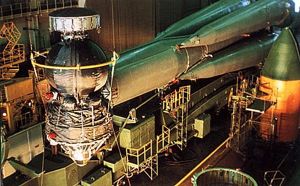 | Foton Foton satellite in its assembly hall, with its booster and payload shroud. The cylindrical module at the top is a Nauka module. |
All geosynchronous satellites were launched from Baikonur by the Proton booster. With rare exceptions the spacecraft were inserted into geosynchronous near 90 degrees East and allowed to drift east or west to their intended stations.
- Molniya: Flight trials of the Molniya-2 were conducted in 1971-1974. Operational flights came in 1974-1977. Molniya-2, like Molniya-1, consisted of four pairs of spacecraft with orbits at ninety degrees to one another. Development of Molniya-3, initially designated Molniya-2M, began in 1972. Flight trials began in November 1974. The Molniya-3 was used to create the 'Orbita' television system for northern regions, with groups of four satellites.
- Raduga: Development of Soviet geosynchronous satellites began at the end of the 1960's. In July 1974 a Proton DM boosted a Molniya-1 into geosynchronous orbit. This was a test for the specialized military Raduga satellites that were to be stationed at 35 degrees and 85 degrees East. Construction of the first Raduga was completed in 1975. A single orbital group of two such satellites could handle all of the military communications of the Soviet eastern regions. Internationally designated Statsionar-1, Raduga represented the first use of the new universal spacecraft bus KAUR-3.
- Ekran: In the first half of the 1970's the development of the Ekran (Statsionar T) civilian geosynchronous system was completed for central television broadcast to Siberia and the Far North. The first Ekran was launched on 26 October 1976. The first flights used experimental satellites, but they already allowed 18 to 20 million additional Soviet citizens to see the Central Television program. Problems with the Proton booster resulted in delays in putting the system into operation.
- Resurs-O: A decree of December 1971 ordered development of the Meteor-Priroda system for remote sensing. This adaptation of the Meteor allowed low resolution multispectral imaging. First launch was on 9 July 74. The Resurs-OE and Resurs-O1 improved versions continued to provide this service through the end of the century.
- Resurs-F: A decree of 21 December 1972 started work on a supplemental high resolution film-return earth resources system. The Zenit-4MKT - Fram spacecraft took multi-spectral photographs on black and white and spectro-zonal film.
- Adaptations of the recoverable Zenit satellite were again used for new purposes. The Bion was developed for biological studies and the Foton for materials science research.
 | Istrebitel Sputnik IS-A Antisatellite satellite. As far as is known, follow-on models and the R-36-launched targets had a similar appearance. Credit: © Mark Wade |
By 1976 Nixon had been ousted from power and the Carter administrations renewed work on ASAT's. This resulted in a new series of trial flights of an improved IS-A interceptor and target (DS-P1-M) through 1978. The last flight tests were conducted in 1982. The Soviet Union unilaterally abandoned anti-satellite operations in 1983. The improved IS-MU version of the system was kept in untested reserve after that date.
The TKS manned ferry spacecraft were tested in unmanned flights and the TKS VA re-entry capsule underwent extensive tests. After cancellation of the Almaz-2 program, surplus TKS resupply craft were flown to dockings with Salyut 6 and 7. Although the TKS had significantly better characteristics than the existing Soyuz spacecraft, it was not put into operation. However this design formed the basis for modules of the Mir and International Space Stations.
-
Manned Lunar Program: In July 1969 the Americans beat the Soviet Union to the moon, but the Soviet N1-L3 project continued. The revised plan envisioned establishment of a lunar base in the late 1970's, after the Americans had completed their Apollo program. This would use dual-launches of new L3M-1970 - L3M-1972 spacecraft by an improved N1F booster. Unfortunately the third and fourth N1 launches were failures. The first N1F was being prepared for launch when the entire program was cancelled in 1974. Glushko replaced Mishin as head of the Korolev bureau.
- Manned Mars Expedition: Flushed with their victory in the moon race, NASA advanced serious plans in 1969 for a manned Mars landing program. The Soviet leadership directed study of a Russian equivalent - Aelita. Korolev's bureau dusted off their earlier studies of the 1960's and came up with the MEK before deciding not to submit a draft proposal. Chelomei completed design of his UR-700M - MK-700. But the Nixon administration quickly axed NASA's ambitious plans and a study of the matter by an expert commission in 1973 decided that the Soviet Union did not have the money or technology for such a project.
- Civilian Space Station: The Korolev bureau planned an ambitious MKBS orbital base lofted by the N1 booster. However continued failures of the N1 put these plans on indefinite hold. After America's landing on the moon and the explosion of the second N1, the engineering staff at Korolev's bureau found itself with no immediate work at hand. There would be a long delay for redesign of the N1, and they had spun off all of their unmanned spacecraft to other design bureaus.
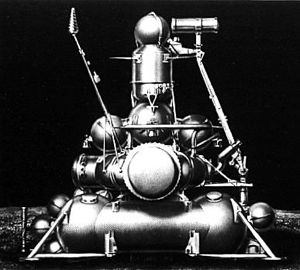
Luna 17 The first launch, Salyut 1 of 1971, beat Skylab into orbit but the crew perished when their Soyuz spacecraft depressurized during the return to earth. Launch and in-orbit failures in 1972 and 1973 were finally followed by the completely successful Salyut 4 of 1975-1976. The cancellation of the N1 in 1974 left Salyut as the only Soviet civilian manned space program.
The Korolev bureau borrowed the two docking port configuration of Chelomei's Almaz-2 and flew Salyut 6 and Salyut 7 in 1977 and 1982. This allowed near-continuous occupation of the stations through crew rotation. The opportunity was taken to fly 'guest cosmonauts' from friendly countries on short visits to the stations. Salyut 7 was able to conduct significant military experiments thanks to the greatly increased volume and payload of the TKS modules diverted from the Almaz programmer.
To support operation of these stations the basic Soyuz design was modified by addition of a docking tunnel. The resulting Soyuz 7KT-OK was used with the Salyut 1 DOS space station. Following the disastrous Soyuz 11 mission, it was again reworked to the simplified Soyuz 7K-T design, which finally provided a reliable ferry craft to Salyuts-4, -6, and -7. A further modification was the Progress, an unmanned logistics vehicle that replaced the crew re-entry vehicle with propellant tanks for resupply of Salyut space stations. These Soyuz 7K-OK derivatives flew until succeeded by Soyuz T in 1981 and Progress M in 1989. These designs were derived from the still-born Soyuz 7K-S, a military version of Soyuz which began development in 1968. From 17 July 1984 Soyuz could be launched with 200 kg additional mass thanks to use of Tsiklin propellant in the Soyuz-U2 booster. Some solo Soyuz missions were conducted apart from the Salyut program. Soyuz 20 carried a biological payload, and Soyuz 22 - Soyuz 7K-MF6 flew a multi-spectral camera.
- Apollo-Soyuz Test Project (ASTP) - Following the moon race and in the atmosphere of the Nixon-Brezhnev détente, meetings began in 1969 to develop a universal docking system for space rescue. A working group was set up in October 1970 and in May 1972 a US-USSR Agreement was signed for a joint manned space mission to take place in 1975. The Soviets developed the modified Soyuz 7K-TM design for the mission. Soyuz 19 (ASTP) and Apollo (ASTP) successfully docked in orbit in July 1975. The worsening cold war prevented further joint missions. The information the Russians acquired during this project helped them reinvent their space technology and program management techniques for the third generation of space systems.
Launch Vehicles
The Ministry of Defense did manage to retire some old launch vehicles. 1974 saw the last launch from KRK Raduga using the Kosmos 63S1M booster. On 29 June 1976 the last Voskhod 11A57 booster was launched. As a result, in 1977 121 launches were made using only six types of launch vehicles and 16 types of spacecraft. Launch facilities at Kapustin Yar were limited to LC-5 and LC-53.
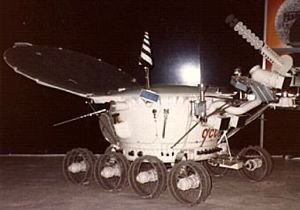 | Lunokhod 1 / Ye-8-LS Mature First Generation Soviet Space Systems Credit: © Mark Wade |
- Light medium launch vehicle: The Kosmos 11K65M continued in service for all lighter satellites. The Kosmos 11K63 was retired.
- Medium launch vehicle: The two-stage Tsyklon-2 continued in service for the US and IS payloads (which were equipped with rocket engines for orbital insertion). Work on the Tsyklon-3 began in the early 1970's. The specification was to deliver 4 metric tons into low earth orbit with high accuracy, requiring minimum adjustment of the operational orbit by the payload. To achieve this a new third stage was developed. A new launch complex for the Tsyklon-3 began construction at the beginning of the 1970's at Plesetsk. The first pad was put into operation in 1977 and the second in 1979.
- Heavy launch vehicle: The UR-500K (Proton 8K82K) itself underwent flight trials from March 1978 to February 1970, a total of 20 flights. The original Block D configuration (Proton 8K82K - 11S824) was used until 1976, at which time it was replaced by a modernized version (Proton 8K82K - 11S86) equipped with N2O4-UDMH verniers for precise placement of payloads in geosynchronous orbit. This was accepted into military service in 1978 with the first Raduga launch. Project work began in 1970, with construction starting in 1972, on Launch Complex LC-200 for the Proton and a new MIK-KA for spacecraft integration. The first pad was completed in 1977, the second in 1978, and the MIK-KA was first used in 1981. These facilities supported launch of the military's second generation systems. The new MIK-KA had two areas for preparation of second generation navigation satellites, one area for preparation of transponder satellites, and five areas for second and third generation communications and electro-optical reconnaissance satellites.
- R-7: The Soyuz 11A511U was a standardized, modernized version of the R-7 launch vehicle with higher performance first and second stage engines. Improvements were made to the launch complexes, including unified test-launch ground support equipment. This was first used on the Apollo-Soyuz launches in the mid-1970's. Military applications included Zenit and Yantar. A modernized Vostok 8A92M launcher remained in service for sun-synchronous orbit payloads. First use was the Meteor launch on 29 June 1977.
Second Generation Soviet Space Systems
Second generation space systems extended support of space assets beyond the strategic forces to tactical military units. In April 1972 50 TsNII KS MO (50th Central Scientific Research Institute for Space Systems of the Ministry of Defense) was decreed. It was empowered to co-ordinate all of the work of the various space research institutions (TsNIIMASH, NIITI, Agat, NII Khimash) on follow-on space systems. The objective was to draft a five year plan for satellites to be used in the 1985-1990 period. 50 TsNII KS MO was formed from staff and facilities of 4-NII MO. It was tasked to put together defense plans, draft TTT and TTZ specifications, and conduct trials of equipment. Research supported the RVSN Rocket Forces in their planning for 1971-1975. These included Plans Sirius Phase 2, Dal', Gamma, and Zamysel. The final result was two plans: "Program for Military Space Units for 1976 to 1985" and "Basis and Direction of Development of Space Units through 1990". These documents defined the Soviet Union's second generation space systems. The plans included:
 | Fwd view of Energia Forward view of Energia launch vehicle in assembly hall at MIK Credit: © Mark Wade |
- Description of the complex research, organized among various institutes, necessary to develop the basic project documents for the plan and to conduct operations analysis and cost-technical trade studies;
- Planning documents for development of space systems in the five years under consideration and follow-on developments:
- Basic direction of military development for 10 to 15 years
- Program to develop military technology during ten years.
- Capital investment plan
- Specific five year plan for consideration of the Defense Ministry and Central Committee for inclusion in the national five year plan (subject to approval by the VPK Military-Industrial Commission).
- Five year plans of basic research
After evaluation by the Ministry of Defense, these plans were approved by the Central Committee of the Communist Party and the Soviet Ministers on 27 February 1976. They included the definition of new research programs in the 1976-1980 period, operational effectiveness studies, organizational studies, and determination of optimal orbits for various satellite constellations. This February decree was a watershed which laid out the systems that would be designed and deployed until the dissolution of the Soviet Union. These plans embodied the response of the Soviet leadership to the technical debacles of the early 1970's - the loss of the moon race, the failure of the N1, the unreliability of first generation spacecraft. Development of the new space systems would use new research, quality assurance, and program management techniques. These would make maximum use of successful American 'best practices' and technology that had won the moon race.
The Soviet Unified Space System consisted of:
- YeSKN - Unified System of Space Reconnaissance, operational 1977, including ICBM early warning systems
- MKRTs - Naval Space Reconnaissance and Targeting System, operational 1976
- YeSSS-2: Unified System of Satellite Communications, Second Generation
- GKKRS - Global Command and Control Space Relay System, operational 1985
- GLONASS - Global Navigation System, operational 1976.
- GMKS - Global Meteorological Space System, partially operational 1976
- TGKS - Topographic - Geodetic Space System, operational 1976
There was considerable controversy as the 'Young Turks' took on the conservatives. The controversy mirrored the 'star wars' arguments of the following decade in the United States - conventional space objectives versus exotic technologies and possibilities. Although preliminary research projects were begun, the weaponization of these concepts did not begin until the mid-1980's.
At the conclusion of the deployment of these systems, the Soviet Union finally achieved military space system parity with the United States. But there were serious delays. By the end of the 11th Five Year Plan (1981-1985), of 23 priority systems requirements, 21 were from one to three years behind schedule. The two that had been completed were finished one year behind schedule. Only 60% of the planned flight trials launches had been completed. In particular delays in development of the new Zenit launch vehicle impacted all the other programs, increasing their costs. Tselina-2 had to be initially launched aboard Proton boosters, and Yantar-4K aboard Soyuz-U.
Second generation Launch Vehicles
A completely new family of dedicated space launch vehicles, not derived from military missiles, would be developed to support the spacecraft. 50 TsNII-KS began research in 1973 on Plan Poisk - a new modular family of launch vehicles. These were in four classes: Light - 3 metric tons payload; Medium, 10-12 metric tons; Heavy, 30 - 35 metric tons; and Super-heavy. The objectives:
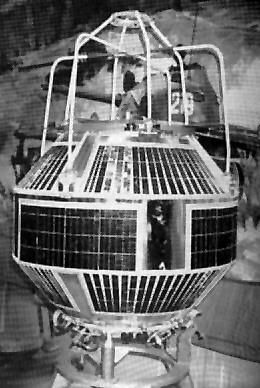 | Strela-1 Strela-1 prototype. Later spacecraft in the series are believed to be similar in appearance. |
- Maximum reliability
- Greatest realistically possible net payload for a given launch mass
- A wide functional range of all elements.
Many concepts were studied. The Universal Modular Approach allowed modules to be thoroughly tested. Conclusions of the study:
- Performance must not be achieved at the expense of reliability
- Universal upper stage for geosynchronous-planetary applications
- Non-toxic Lox-Kerosene propellants for cost and safety reasons
- Autonomous guidance systems that could be programmed for many trajectories. Flexible, able to handle failure modes and flight deviations
- Full tests of launch vehicles prior to service:
- Mock-up tests to provide maximum realism for facilities check-out and staff training. These would include:
- Mass-dimensional mock-up to test transportability, assembly and launch handling
- Electrical mock-up to develop flight trials technical and launch positions
- Fueling mock-up to test tanking-detanking (at first with substitute fuel components).
- Flight tests: First launches would be made with mock-up payloads, replicating mass and telemetry characteristics of real payloads, but with heavy instrumentation of the launch vehicle and television observation to allow analysis and corrective action of failures.
- Mock-up tests to provide maximum realism for facilities check-out and staff training. These would include:
- All launch vehicles to be of two stages
- Launch vehicles of the basic classes would be built from common modules (first stages, engine sections, guidance systems)
- Launch vehicles must use non-toxic propellants
- Launch vehicles must make all possible maneuvers to drop the first stage in the designated drop zone
- Digital guidance systems would be used that were flexible and able to handle all trajectories and emergency situations. The systems would be autonomous and not require updates or assistance from earth-based systems. They would be able to place the payload into a precise orbit, with orbital injection accuracy subject only to the accuracy limits of the launch vehicle propulsion system
- Preparation of the launch vehicle at the launch pad would require minimum time and personnel
- Ground support equipment would be multi-purpose and computer-based
- The highly reliable launch vehicles would use computer-based ground support equipment, automated check-out, self-diagnostic systems, automatic countdown and launch abort modes
During these studies the launch vehicle engineering bureaus responded with designs meeting the needs of the military: the UR-500MK from Chelomei, and the RLA-120-RLA-135-RLA-150 family from Glushko. Glushko's emphasis was on the super-heavy vehicle to support a continued lunar base project.
But the VPK Military-Industrial Commission and the national leadership rejected the approach favored by the Ministry of Defense. Instead the instructions were to provide a precise Soviet equivalent to the American space shuttle system, notably in use of a Liquid Oxygen-Liquid Hydrogen core vehicle. The KRK principles were applied to this design. The resulting MKS launch vehicle consisted of the Buran, Energia, and Zenit-2 systems. But this system did not have the flexibility required by the Ministry of Defense. From this situation only the following military objectives could be salvaged:
- Fulfillment of the super heavy launcher requirement (Energia - use of the system without Buran gave a 100 metric ton payload to low earth orbit - but the Ministry of Defense had identified no such payload yet)
- Fulfillment of the medium launcher requirement (Zenit-2) by using one of the lateral strap-on booster blocks of the Energia and a new upper stage.
- Demonstrate science and technology
- Obtain 'ecologically friendly' high energy Lox-LH2 propellant technology
- Long-term research on electronics and cryogenics

US-P
Credit: © Mark Wade
Because of all the new technology, development of Zenit-Energia went very slowly. Since the Ministry of Defense’s requirements for new launch vehicles had not been met they had to rely on continued use of old classes of boosters. The existing Kosmos 11K65M, Tsyklon-3 and Proton 8K82K would be used for the light and heavy-class payloads.
Work on the Zenit launch complex began in 1978. The first pad was ready in December 1983 but due to delays in development of the first stage engines flight trails did not begin until 13 April 1985. In the spring of 1987 state commission that accepted the basic system for military use, but much work remained to be done. This included construction of a second launch complex at Baikonur, qualification of a third stage for geostationary payloads, and construction of a third launch complex at Plesetsk.
The same engine problems delayed test of the Energia-Buran vehicles. A comprehensive plan for use of Buran for military, scientific, and national economic purposes was approved on 11 July 1984, which by then was two years behind schedule. Buran itself was finally prepared for flight tests in 1986. This marked the end of a huge development effort using 200 experimental test stands, 34 full-scale test units, and 5 full-scale articles in over 6,500 separate qualification tests. The Polyus-Skif-DM experimental military payload was assembled for the first flight.
Second Generation Space Systems
The development of satellites taking advantage of the new design principles and technologies could not be delayed for development of second generation boosters. Therefore most space systems were to be developed in two phases: Phase 1 for launch using existing launch vehicles (Tsyklon-3, Soyuz 11A511U, or Proton 8K82K) and Phase 2 for launch by Zenit-2. Due to delays in development of the Zenit booster, very few of the Phase 2 systems reached flight stage before the collapse of the Soviet Union.
- YeSKN: Unified System of Space Surveillance, including the SPRN ICBM early warning system
- Reconnaissance satellites: The Yantar-2K film-return satellite was not capable of providing strategic warning of attack. The ultimate solution was a purely electro-optical satellite constellation with multi-spectral capability and high resolution. The spacecraft would be designed to relay visual and infrared band images via a digital data link to the planned Potok-Luch GKRSS relay satellite system. The new satellite was required to have the resolution and spectral capability of the American KH-11 system. However it was clear that Soviet technology would not be able to develop a single satellite meeting this requirement in Phase 1. Therefore three variants of Yantar had to be developed in Phase 1 to match the KH-11:
- Yantar-4K film return satellite for high resolution - multi-spectral reconnaissance. The initial Yantar-4K1 model with two film-return capsules was to be succeeded by the Zenit-launched Yantar-4K2 with 22 film return capsules and designed for missions of 120 to 180 days. Flight trials of the phase 1 system began in 1979 and were completed after eight flights in 1982, when the system was accepted into the military. Improvements from the Yantar-2K included a 17 day increase in mission endurance to 60 days, more film, and the capability to image targets 60 degrees left or right of the ground track. Due to excessive work at the Progress factory, production spacecraft were built from 1984 at Arsenal, Leningrad. The Yantar-4K2 design never flew and was abandoned after the break-up of the Soviet Union.
- Orlets-Yantar-6K film return satellite for wide-band detail and survey reconnaissance. This underwent protracted development and did not enter service until the 1990's in the Orlets-1 and Orlets-2 versions. Orlets Phase 1 used 8 return capsules and a wide-band panoramic camera. Phase 2 would be equipped with 22 capsules and be launched by Zenit.
- Yantar-6KS electro-optical satellite for detailed and operational reconnaissance. This version dispensed with the film return capsules and provided real-time transmission of imagery. Work began in 1975, but the plan ran into problems when the May 1977 draft project indicated weight growth beyond the payload capabilities of the Soyuz booster. So instead a less-capable spacecraft based on the Yantar-4K bus was designed. The first phase spacecraft, the Yantar-4KS1, would begin flight trials in 1979, with the more capable Yantar-4KS2, launched by Zenit, to begin flight trials in 1983.
Development was slow because of the state of Soviet digital electronics technology. Flight trials of the Yantar 4KS1 finally began in December 1982, three years behind schedule. The system was accepted by the military in 1985 and six launches were conducted through 1986 of Phase 1 systems. Phase 2 was proceeding in parallel. A resolution of 1 June 1983 required it to be equivalent to the American KH-11. Trials began in 1985 and consisted of three launches. In the end it proved impossible for the Yantar-4KS2 to match the performance of the KH-11. All Yantar-4K systems went through evolutionary development from flight to flight.
- ICBM Launch Detection System - The first generation Oko system, using a four-satellite constellation in Molniya orbits, could not provide 24 hour observation of all possible launch locations. Therefore development began of a replacement system began in 1980. It supplemented the Oko satellites with Prognoz SPRN satellites in geosynchronous orbits. In order to provide full time coverage of enemy missile launches nine operational satellites were required - four were needed to cover the US land mass alone. The system was accepted in to service in March 1985. Seven launches were made in 1984-1986, with 3 to 4 per year required thereafter to keep the system in operation. This work completed the Unified System of Space Surveillance (YeSKN).

DLB Module Deployed
View of the DLB Soviet lunar base modules as they would appear deployed on the lunar surface. - ELINT Satellites: Based on the first generation Tselina ELINT, TsNII-KS at the beginning of the 1970's developed the specifications for an improved model with increased frequency range and an on-board method of determining the position of fixed transmitters. Work on the Tselina-2 was authorized in March 1973. The draft project was drawn up in the first quarter of 1974 and the Ministry of Defense approved the TTZ specification in May 1974. After a long review process the VPK issued the project plan for development of the system in December 1976. Replacing the separate earlier Army-Navy systems, it would use the Zenit launch vehicle and have increased mass and lifetime. Data received would be transmitted directly to ground stations via Potok geosynchronous communications satellites. This real-time data transmittal and other improvements would allow prompt identification and localization of enemy land and sea units. The first flight trials system was completed in December 1980, but the Zenit rocket continued to experience delays. Finally a resolution was issued in September 1984 to launch the satellite on a Proton booster. Gherman Titov was in charge of the state commission for the launch. On the sixth launch the satellite was lost in a catastrophic launch disaster. Zenit-boosted flights finally began in 1985 and the system was accepted into service in 1987.
- In the 1976-1982 five year plan the Almaz-T automated station with the Mech-K side-scan radar was to be deployed. Operations analysis had indicated that two automatic Almaz-T would be a necessary adjunct to the Yantar and Tselina satellites. TsSKB began work with six ministries on such a vehicle. In 1981 Almaz-T was ready for flight trials, but Ustinov mothballed it. He wanted TSKBM to concentrate on ICBM development. After Ustinov's death in 1984 the two trials satellites were finally launched, but as civilian satellites.
- MKRTs Naval Reconnaissance System. Work on a second generation naval electronic reconnaissance system began in 1978. Specifications for the MKRTs system were developed co-operatively by Ministry of Defense, Soviet Navy, GUKOS, and TsNII Kometa (Savin) in 1978-1980. Following approval by the VPK Military Industrial Commission, the development was to have begun in the Eleventh Five Year Plan (1981-1985). The Pirs-1 system represented Phase 1, with the draft project completed in 1982. Pirs-2 was to start technical development in 1982, and provide double the capability to observe ships, and potentially submerged submarines. The radio and radiotechnical ELINT mission of the first generation US-P naval reconnaissance satellites would be handled by the interservice Tselina-2. Development of the draft project required three OKB's to co-operate due to the use of the new Zenit launch vehicle: NPO Energia, PO Arsenal, and TsKBM. The complete Ideogramma-Pirs system was to have been deployed during the Twelfth Five year plan (1986-1990). The nuclear-powered US-A system was abandoned in 1988 due to continued reliability problems and international incidents when the reactor cores of the satellites inadvertently crashed to the earth. The modernized US-PU universal satellite continued in use.
- Reconnaissance satellites: The Yantar-2K film-return satellite was not capable of providing strategic warning of attack. The ultimate solution was a purely electro-optical satellite constellation with multi-spectral capability and high resolution. The spacecraft would be designed to relay visual and infrared band images via a digital data link to the planned Potok-Luch GKRSS relay satellite system. The new satellite was required to have the resolution and spectral capability of the American KH-11 system. However it was clear that Soviet technology would not be able to develop a single satellite meeting this requirement in Phase 1. Therefore three variants of Yantar had to be developed in Phase 1 to match the KH-11:
- YeSSS-2: Unified System of Satellite Communications
-
It was agreed in 1982 to develop an updated YeSSS-2 new generation Unified Satellite Communication System for both civilian and military general use. From 1983 onward this consisted of four Molniya-1T, four Molniya-3, and four modernized Raduga-1 geosynchronous satellites. These were capable of communication with mobile platforms.
Development of a second generation Strela-3 system for centralized command and control of military units began in 1973. Flight trials began in 1985 and the system was accepted into military service in 1990. By 1992 Strela-3 replaced the Strela-1M and after 1994 the Strela-2M in the strategic communications role. Six Strelas were put into medium earth orbits with each launch.
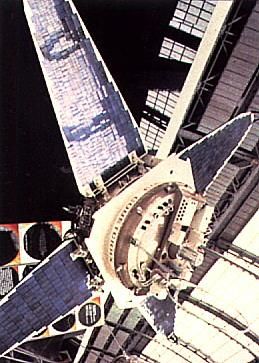
Prognoz The Intersputnik international system was expanded to 14 socialist countries, for a total of 20, including Algeria, Angola, Spain, Italy, Iraq, USA, France, Yugoslavia, and Japan. The system used six transponders aboard two Gorizont satellites.
Use of Inmarsat international maritime communication satellites began in 1975. By 1985 43 civilian users were operating in the Soviet Union. On 1 February 1982 Soviet use of MARECS-A (ECS-OTS) and Intelsat-5 satellites started. The USSR developed the shipboard receiver Volna-S, operated in conjunction with central relay stations at Odessa and Nakhodka. By the end of 1985 over 3500 ships had receivers for Inmarsat and Cosmos-SARSAT. Three Soviet Nadezhda and one US satellite made up the SARSAT emergency distress receiver network.
- GKKRS: Global Command and Data Relay System
A new-generation global command and control system (GKKRS) was to be developed according to the decree of 17 February 1976. This enabled geosynchronous relay of high-rate digital data from both fixed ground stations and mobile platforms (orbiting satellites, aircraft, naval and army units). The first half of the 1980's saw development and flight test of the two satellites used in the GKKRS. At first these relay systems were not fully utilized due to delays in development and deployment of the second generation satellites that would work with them. But they were the key to the other unified systems. The GKKRS consisted of:
- The Potok spacecraft, which handled digital data communications between fixed points and the Yantar-4KS1 electro-optical reconnaissance satellite and Tselina-2 ELINT satellite. Flight tests began in 1982. Potok was the first communications spacecraft built by the Lavochkin design bureau. The same bus was later used for the Kupon civilian satellite.
- Luch spacecraft, which provided communications service to the Mir space station, Buran space shuttle, Soyuz-TM spacecraft, and mobile fleet communications for the Soviet Navy.
- The Potok spacecraft, which handled digital data communications between fixed points and the Yantar-4KS1 electro-optical reconnaissance satellite and Tselina-2 ELINT satellite. Flight tests began in 1982. Potok was the first communications spacecraft built by the Lavochkin design bureau. The same bus was later used for the Kupon civilian satellite.
- YeKNS Unified Space Navigation System
-
GLONASS: Global Navigation Satellite System: At the end of the 1960's the military identified a need for a Satellite Radio Navigation System (SRNS) for use in precision guidance of the planned new generation of ballistic missiles. The existing Tsiklon - Tsikada satellite navigation system could not be used for this purpose. In 1968 to 1969 research institutes of the Ministry of Defense, Academy of Sciences, and Soviet Navy worked together to establish a single solution for air, land, sea, and space forces. In December 1976 a decree was issued by the Soviet state for establishment of the YeKNS-GLONASS Global Navigation Satellite System. The schedule was revised in August 1979 and July 1981. The draft project was completed in 1977-1978. A decree of 29 August 1979 scheduled flight trials of 4 to 6 prototypes in 1981, preliminary acceptance of a 10-12 satellite constellation by 1984, and operation of the complete 24 satellite system by the end of 1987. Actual flight trials began in October 1982, followed by a total of 22 spacecraft by the end of 1987, and 31 by the end of 1989.
- The older Parus - Tsikada navigation system continued in service in parallel. Some of these satellites were upgraded with international emergency distress signal detectors (Nadezhda).
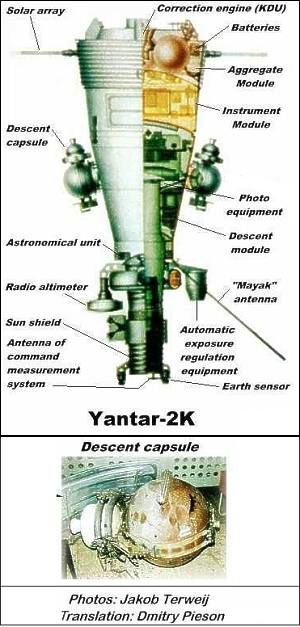
Yantar-2K Cutaway
Credit: Dmitry Pieson -
GLONASS: Global Navigation Satellite System: At the end of the 1960's the military identified a need for a Satellite Radio Navigation System (SRNS) for use in precision guidance of the planned new generation of ballistic missiles. The existing Tsiklon - Tsikada satellite navigation system could not be used for this purpose. In 1968 to 1969 research institutes of the Ministry of Defense, Academy of Sciences, and Soviet Navy worked together to establish a single solution for air, land, sea, and space forces. In December 1976 a decree was issued by the Soviet state for establishment of the YeKNS-GLONASS Global Navigation Satellite System. The schedule was revised in August 1979 and July 1981. The draft project was completed in 1977-1978. A decree of 29 August 1979 scheduled flight trials of 4 to 6 prototypes in 1981, preliminary acceptance of a 10-12 satellite constellation by 1984, and operation of the complete 24 satellite system by the end of 1987. Actual flight trials began in October 1982, followed by a total of 22 spacecraft by the end of 1987, and 31 by the end of 1989.
- GMKS: Global Hydrological and Meteorological Space Monitoring System
-
Delays in Meteor-2 development led to a resolution of 4 June 1970 to develop a parallel design for the hydrology office alone. This was not put into production. In its place a resolution of 16 December 1972 ordered development of a second generation system. This used the Planeta-S sensor package in the non-co-orbital Meteor-3 system plus a geostationary system Elektro, which was to begin tests in 1982. Elektro suffered numerous delays due to equipment and software problems, and went through two heads of development. However the effort did not receive adequate funding until 1983, by which time it was considered a third generation system.
A series of ambitious ocean satellites were introduced, perhaps with the intention of solving the problem of detection of submerged enemy ballistic missile submarines. The Okean-E and Okean-OE were experimental satellites used to develop sensors for the Okean-O satellite being developed by KB Yuzhnoye. They surveyed the ocean surface and arctic ice pack using a variety of sensors. Salyut 7 conducted a joint sensor program with Okean-OE-Cosmos 1500. The Okean-OE satellites also received data from a world-wide network of ocean buoys that had been deployed from the end of the 1960's. Receivers for these buoys were carried on Kosmos 243, Meteor, Soyuz, Salyut, Kosmos 1076, Kosmos 1151, Intercosmos 20. The Okean-O1, sized for launch by the Tsyklon, began flights in 1986. The Phase 2, Zenit-launched Okean-O was delayed for a long time but finally reached orbit in 1999.
- TGKS: Topographic - Geodesic Space System
-
Following cancellation of the Yantar-1KF cartographic satellite the decision was taken to develop the Yantar-1KFT, based on the Yantar-2K bus. Development of this replacement satellite was authorized in a resolution of 3 February 1977. Camera development was difficult, and flight trials did not begin until 1981. The system was finally accepted into service in 1987. Yantar-1KFT imagery was combined with topographic information from the Zenit-4MT to build up high precision military maps.
The Geo-IK second generation geodetic satellite system began development in 1977. Its Musson satellite was used to define a unified world geodetic data set and geocentric co-ordinate system, characterize the shape of the earth, and precisely fix the location of NIP tracking stations. Flight trials began in 1980, and the system was accepted into service in 1986. The system used the Tsiklon-3 launcher and the entire system, including ground elements, was known as Geo-IK.
Two Etalon geodetic satellites were also flown in the 19,100 km GLONASS orbit to fully characterize the gravitational field at the planned altitude and inclination.
National Prestige Projects
- Mir Space Station: The design of Mir, an improved model of the Salyut DOS-17K space station, was authorized as Phase 1 of the second generation of Soviet space systems in the 17 February 1976 decree. At that time it was planned that the two stations (DOS-7 and DOS-8) would be equipped with two docking ports at either end and an additional two ports at the sides of the forward small diameter compartment. By the time of the draft project in August 1978 this had evolved to the final Mir configuration of one aft port and five ports in a spherical compartment at the forward end of the station. Mir was to have had only a three to five year life, but ended up in service into the next century.
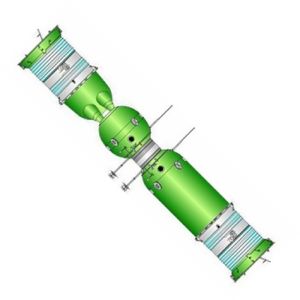
Soyuz VI / OIS
Mishin's version of Soyuz VI with OIS light space station (conceptual drawing based on description).
Credit: © Mark Wade - Manned Planetary Exploration: Attempts by Glushko to interest the Soviet leadership in a renewed lunar program were unsuccessful. The Energia launch vehicle would have been used for launch of a lunar base using an array of new spacecraft (LK Energia, LOK Energia, Lunokhod LEK, LZhM, LZM). From 1978 the Energia was also studied for boost of the Mars 1986 manned Mars expedition. However there was no political support for such an 'adventure' in the absence of competing American programs.
- Scientific Satellites
- Planetary Probes: The Soviet Union could not achieve the spacecraft component reliability required to match the decade-long explorations of outer planets undertaken by the Americans. A scaled-down program of probes to Mars, Venus, and Halley's comet continued using the 4MV spacecraft bus. A new design 5MV was developed but flew only a few times with poor results. This include the 2 Vega spacecraft launched on 15-21 December 1984
- The Prognoz-M was developed for the international Interbol project to further measure solar activity, solar wind, and the interface of the earth's magnetosphere with the solar wind. Its flight was delayed until the 1990's.
-
A decree of 5 May 1977 authorized development of three earth resource satellites. The Ministry of Defense was tasked with developing these systems, even though they did not contribute directly to any military mission. Despite this political decision, the orders were followed. These new Resurs satellites provided continuous photo surveillance for cartographic and economic surveys, development of technical maps, and earth resource surveys. It was claimed that they paid back their cost by a factor of 4 to 5 times. Resurs-F flight trials began in 1979 and it was put into service in 1981. The spacecraft was based on the Fram design. In 1981-1983 it surveyed 83% of Soviet territory in multispectral color imaging, 97% of the territory in monochrome. In the process it made new discoveries of oil and gas fields. The family was extended during the 1980's to include the Resurs F1-17F41 - Resurs F1-14F40 - Resurs F1-14F43 - Resurs F1M - Resurs F2 versions.
- The Astron X-Ray Astronomy Satellite was developed at Lavochkin by Kovtunenko. The sensor payload was developed by A B Serveniy of the Crimean Observatory of the Academy of Sciences and included an ultraviolet telescope and Roentgen X-ray detector. The satellite was placed in a high elliptical orbit in March 1983 and operated for five years. During that time it detected 15 pulsars and compact relativistic objects in binary star systems. Tests with the telescope also showed it would be useful in military reconnaissance systems.
-
The Oreol 3 collaborative French-Soviet satellite used the Yuzhnoye AUOS bus and carried magnetosphere and ionosphere experiments.
- Two Efir satellites were developed according to a May 1982 VPK Resolution and launched in 1984. The spacecraft was derived from the Zenit reconnaissance satellite and conducted research on very high energy cosmic rays.
- The IK-B-1300 Interkosmos-Bulgaria-1300 flew once in August 1981. It was built by KB Yuzhnoye to study the troposphere. A Meteor-2 satellite bus was used together with Bulgarian instruments. The 1300 designation celebrated the 1300th anniversary of Bulgaria.
- Launch of international collaborative Bion biological missions continued through 1996.
- The Indian Bhaskara satellites were developed under a joint project. They conducted research on use of space sounding sensors and tested a range of other technical equipment.
- Planetary Probes: The Soviet Union could not achieve the spacecraft component reliability required to match the decade-long explorations of outer planets undertaken by the Americans. A scaled-down program of probes to Mars, Venus, and Halley's comet continued using the 4MV spacecraft bus. A new design 5MV was developed but flew only a few times with poor results. This include the 2 Vega spacecraft launched on 15-21 December 1984
Third Generation Soviet Space Systems
Third generation Soviet space systems constituted an integrated Multi-Element Space System, including the planned Multi-echelon Anti-Ballistic Missile System. Preparatory work for third generation systems was undertaken under the Tenth Five Year Plan (1976-1980), with full definition of the systems in the 11th Five Year Plan, (1981-1985). In 1985 the plans were drastically revised and a crash programmer was undertaken to meet the American Strategic Defense Initiative challenge during the 12th Five Year Plan (1986-1990). Third generations systems were to be fully on line by 1990. This plan was not achievable and the Soviet Union disintegrated before any third generations systems could be placed in service.
Research institute 50-TsNII-KS GUKOS conducted studies in 1976-1980 on the third generation of satellite systems. These would have a 10 to 15 year development and deployment cycle. Participating in the studies were the Academy of Sciences, scientific institutes, and industry. Among the resulting studies were those code-named Gorizont-K, Dal, Zamysel-95, and Klokot. Project Borba studied the operational strategic problems of military activity in space. Shturm-2 identified the military, scientific, and technological research and development required for third generation military space units. The final results of the studies were summarized in the reports 'Basic Direction of Military Space Unit Development to 1995' and 'Program for Military Space Units, 1981-1990'. Approval of these plans from the Central Committee and Soviet Ministers was issued on 2 June 1980. This covered the period through 1990 and included plans for use of the Almaz-T multimode reconnaissance system and Elektro geosynchronous meteorological satellite.
Further operational studies included the 16 volume OTT-70 which set forth system specifications and force descriptions. RK-75 set forth the order of battle for both space and rocket forces. At the end of 1980 the VPK Military Industrial Commission also ordered a strategic plan extending to 1995 and a plan for research to 2000.
These plans were drastically revised as a result of what the Soviet Union perceived as the remilitarization of space by the United States with the F-15 ASAT and Shuttle programs. At this time second generation Soviet space systems were supporting the military, but 25% of the new systems were behind schedule (Yantar-4K, Geo-IK, and Strela especially). The use of space for combat, especially plans for use of the Buran spaceplane, were not taken seriously by the Ministry of Defense. In April 1976 Ustinov had authorized work to start on military space combat systems, but by 1979 the development work was unfocussed.
The leadership at GUKOS (Main Directorate of the Space Forces) wanted to collect all of these diverse projects into a single organization. This Space Force would be equal to the RVSN Strategic Rocket Forces in status. This was opposed by RVSN, but on 10 November 1981 a decree made GUKOS responsible for all space forces and satellites. GUKOS was tasked with ensuring synergistic organization of satellite constellations; co-ordination of the ABM anti-ballistic missile forces and SPRN early warning satellites with the PVO Air Defense Force; co-ordination with the VVS Air Force on use of space reconnaissance data and cosmonaut training; and operation of the space tracking system.
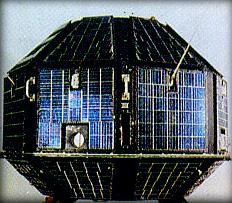 | Aryabhata Credit: ISRC |
- Development of new space systems to detect preparations for surprise nuclear attack, to locate the position of nuclear explosions, and to enforce the START-2 treaty
- Modernization of existing reconnaissance, communication, and navigation systems
- Introduction of the Buran and Zenit boosters into service
- Preliminary research on a new class of light and heavy launch vehicles of the next generation
This plan was submitted to a special session of the Ministry of Defense in August 1981. It envisioned development of 8 new space systems plus the Tsiklon-3 booster with a new upper stage. The integrated Global Space System would consist of multiple subsystems:
- YeSSS Communications System
- GKKRS Command-Relay System
- Uragan Navigation System
- TGKS Geodesy, and Earth Database System
- Planeta Hydrological-Geological System.
- Continuous Observation Operational Space System
- MKRTs Naval Targeting System
- Multi-echelon Anti-Ballistic Missile System
Multi-echelon Anti-Ballistic Missile System
At the end of the 1960's and the beginning of the 1970's the United States began new research in the use of spacecraft for the destruction of military targets in and from space. In the late 1960's development began at Lawrence Livermore Laboratory of a space-based nuclear weapon-pumped laser. This was originally envisioned as a fearsome weapon, consisting of several dozen independently aimed lasing rods arranged around the bomb. When the bomb exploded, a large percentage of its force would be conducted down the lasing rods toward the targets at which they pointed (in the microsecond before the rods themselves vaporized).
At the same time the Air Force and NASA were studying reusable space shuttles. A single shuttle payload bay of such weapons had the potential of destroying the entire Soviet ICBM force - not just in launch phase but in a first strike, frying them right through the silo covers. One of the most heavily classified projects of the time, it still came to the attention of Soviet intelligence.
During this same period NASA was struggling to justify a post-Apollo space program. The Nixon administration decided that the USAF shuttle project would be dropped, and their requirements incorporated into the NASA design. One of these requirements was a mission involving a launch into polar orbit from Vandenberg Air Force base, release of unspecified payloads into orbit, and return to Vandenberg after a single orbit of the Earth. This requirement forced NASA to drop their preferred straight-wing design for a heavier double-delta wing that had the necessary cross range. The Soviet leadership saw their worst fears confirmed. This was a modern version of the first-strike multiple-warhead UR-500 and N1 super heavy rockets which they had developed but then abandoned in the early 1960's.
America was also beginning work on other directed energy approaches that did not require use of nuclear detonations. In 1968, a gas dynamic laser was reviewed in a study to see if it would be a viable as a satellite anti-missile system. In 1971, the Aerospace Corporation developed a prototype infrared fluorine-hydrogen laser. By 1975, Lockheed put together the first concept of a satellite armed with a laser and a deployable mirror.
 | Fram |
During the late 1960's and early 1970's Soviet research institutes, design bureaus, the Academy of Sciences, and the General Staff conducted numerous discussions and unofficial studies. Among these plans were the use of the Korolev MKBS space station as a platform for a neutral particle beam weapon and logistical support of a constellation of military interceptor vehicles. The MKBS approach was abandoned when the N1 launch vehicle was cancelled.
An April 1976 decree began definitive project work on 'Star Wars' technology within the Soviet Union. To develop space weapons the two-phase Fon program was undertaken. Fon-1 encompassed fundamental research and draft project work on a variety of technologies - laser weapons, neutral particle beams, electro-magnetic rail guns, new orbital interceptor missiles, new conventional and nuclear warhead technologies, new anti-ballistic missiles, and space platforms to support these weapons. Fon-2 would take the technologies selected as a result of Fon-1 and conduct flight trials of prototype systems. Fielding of operational space combat units would only come thereafter.
The MOP Ministry of Defense Production set up a new Eighth Main Directorate to manage the work of the various institutes and bureaus. P S Pleshakov of the Ministry of Radio Industry oversaw the work of the design bureaus. In the 1970's and 1980's ambitious and complex research was conducted on space vehicles capable of destroying rockets in flight, airborne vehicles in the atmosphere, vessels at sea, and targets on land. These studies assessed both the feasibility and affordability of such spacecraft.
Early results were not encouraging. NPO Kometa (A I Savin), manufacturer of the existing IS-A anti-satellite system, was asked to study the feasibility of a conventional system to destroy 10,000 ballistic re-entry vehicles and cruise missiles within 5 to 25 minutes with an effectiveness of 99.8%. The study concluded that such a system was not practical technically or economically.
Directed energy weapons might have a better chance of engaging many targets in a surprise attack, but testing of charged practical beam technology resulted in many technical problems that would take a long time to solve. (The 1976 conclusion of the US Defense Intelligence Agency that such work had reached an advanced stage at an immense facility at Semipalatinsk was shown to be incorrect after the fall of the Soviet Union).
Laser technology was also pursued but also faced many technical and cost problems in achieving high energies. The principle center for laser research was TsKB Luch, headed by Nikolai Ustinov, son of the Soviet Defense Minister. In the late 1970's this was reorganized into NPO Astrofizika. Astrofizika designed lasers for both tactical and strategic use and was receiving 1% of the Soviet defense budget during this period. A free electron laser was tested at Storozhevaya, and a 1 MW gas laser at Troitsk.
OKB Vympel was the systems integrator for ground-based laser systems. They built the major Terra-3 laser testing center at Sary Shagan, which was eventually equipped with Astrofizika high power red ruby and carbon dioxide lasers. But the energies were not sufficient for anti-ballistic missile use. The first applications would be limited to anti-satellite operations, and then primarily to blind optical sensors.
 | Ekran Credit: © Mark Wade |
Meanwhile Livermore work on the nuclear-pumped laser had evolved into a space-based x-ray laser weapon which would destroy ICBM's during boost phase, after they had cleared the atmosphere. But in 1977 President Carter cancelled further development work on this weapon. The threat seemed to recede and by the early 1980's Fon-1 work had focused on the more achievable goal of improved interception and destruction of enemy satellites.
But in June 1982 America announced its intentions to test a new SRAM-Altair ASAT from an F-15 fighter. Later that year Edward Teller dazzled Ronald Reagan with tales of desk-sized x-ray lasers that could be deployed within four years and create an invulnerable defense shield around the United States. Work on the x-ray laser was renewed with vigor as the Strategic Defense Initiative (SDI). The program quickly expanded to include research on a broad range of directed energy and rocket interceptor weapons.
Reagan's 'Star Wars speech' on 23 March 1983 seemed to indicate a much earlier deployment than the Soviets had previously thought. Plans were made in America for deployment of the existing Vought MNV warhead developed for the F-15 ASAT. 40 to 45 of these homing vehicles, weighting 2.0 to 2.5 metric tons each, would be housed in orbital platforms in 65-degree inclination, 550 km orbits. Test and deployment of the constellation was to begin in five to seven years. Later studies indicated 30 to 40 such platforms would be deployed with 1350-1800 interceptors.
The Soviet response was immediate. Yuri Andropov ordered additional funding and implementation of Fon-2. At the same time Soviet diplomatic initiatives were undertaken. A proposal was made to the United States to ban all space-based weapons. Andropov declared a unilateral moratorium on testing of the improved IS-MU ASAT. As a 'warning shot' the Terra-3 complex was used to track the STS-41-G space shuttle Challenger with a low power laser on 10 October 1984. This caused malfunction of on-board equipment and temporary blinding of the crew, leading to a US diplomatic protest.
Premier Andropov brought the necessary new discipline and enthusiasm to begin development of Soviet counterpart systems. In response to reports that the US intended to have SDI operational in 10 to 15 years, Minister of Defense Ustinov and VPK Chief Smirnov ordered an urgent revamping of the 11th Five Year Plan (1981-1985). The objective was deployment of space combat systems at the earliest possible date. Total space program expenditures to cover these systems were to be increased 35% from the 11th to 12th Five Year Plans (1986-1990) and 50% from the 12th to 13th Five Year Plans (1991-1995).
However the top-level managers that ran the Soviet space program were fading into history. Afanasyev left MOM (Ministry of General Machine-Building) in 1983. When Ustinov died in December 1984 the Soviet space program lost its biggest backer. He had been the impetus behind development of Buran and the electro-optical reconnaissance systems. He was the leading proponent of a vigorous Soviet response to Star Wars.
The Baikonur and Plesetsk launch centers were reorganized in 1984, with the Baikonur 5 NIIP MO incorporating the 50 TsNII KS research institute, including a new 8th Directorate for operation of the Buran shuttle and BKS Combat Shock Space System - alternative space weapons. The living facilities at the Golistsino-2 command and control center were also upgraded.
 | Tsikada |
The final conclusion was that new, fully reusable, more economical launch vehicles would be required to support the enormous launch rate required for SDI. Concurrent with this studies were made of ecologically clean, high power rocket engines needed to power a new generation of launch vehicles. Lox-Kerosene or Lox-LH2 propellants would be used by a modular family of launch vehicles with payload capabilities of 5 metric tons, 10-12 metric tons, 20-30 metric tons, 40-50 metric tons, and 80-100 metric tons. A common engine would be used in the first stage of all of these designs, which would be recoverable and reusable.
Aircraft-space systems with horizontal takeoff and landing would achieve a 30% reduction in system weight compared to conventional vertical takeoff. Use of nuclear energy was also considered under project MG-19, but development of such a system did not seem possible in the short term.
Analysis of the shuttle indicated that the design was a 'clunker' - it wasted 70 metric tons of orbiter mass on every flight to deliver 30 metric tons of payload. The Chelnoka study evaluated maneuvering aerodynamic-orbital dynamic systems to attack enemy satellites. Buran did not seem suited to this but could be used as a laboratory to develop new space technology. There was a need to test systems in orbit, and the Salyut and Mir space stations would allow this. Technology testing aboard these existing platforms would lead to a new generation of space systems by the turn of the century. These reparable and upgradeable space platforms that would be tended by Buran shuttles.
Concurrent with these urgent moves the Soviets began a diplomatic counter-offensive to kill the American SDI programmer through less-expensive means. This had been launched in earnest at a conference in Vienna on 9-25 August 1982. A series of UN Resolutions in August 1981 (36th UN General Assembly), 1982 (38th General Assembly), and the 12 December 1984 (39th General Assembly) all condemned and attempted to prevent the militarization of space. These resolutions were entirely in response to the initiatives of the Carter and Reagan administrations. The hostile intentions of the Americans were also evidenced by the 1982 NATO First Strike Policy, which went back to McNamara.
On 10 March 1985 Gorbachev came to power and on 12 March he asked for Geneva talks on nuclear and space forces. Nevertheless in May 1985 the US had formed the Strategic Defense Initiative Organization (SDIO) to develop a multi-echelon ABM system. In September 1985 the US intercepted the SolWind satellite at an altitude of 450 km using an F-15-launched ASAT with an infrared seeker. The USSR conducted ASAT research as well, but had never engaged in a massive 'star wars' program on the scale of the American effort. In the Soviet view the concept of SDI was flawed - the necessary technology was an illusion. But the threat was real, and it was determined that even deployment of a flawed American system would upset the strategic balance.
America rushed the second generation ASAT into development. On 19-21 November 1985 Gorbachev and Reagan conducted summit talks in Geneva. The diplomatic efforts were having the desired effect - in December 1985 the US Congress stopped further ASAT tests as long as the Soviet Union did the same.
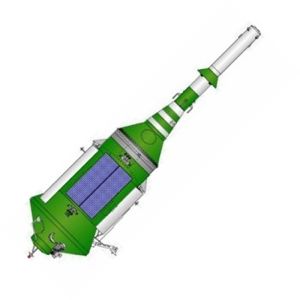 | TKS Manned Ferry TKS manned space station ferry. Credit: © Mark Wade |
The Ministry of Defense determined to proceed with a response to America's SDI at a meeting on 8 November 1985. The financial plan was ready on 7 December 1985. The concept was for a Multiple-Element ABM system costing 30.7 billion rubles in 1986-1990. A government commission headed by Academy of Sciences Vice President Ye P Velikhov reviewed the plan on 11 December 1985. It was then presented to the VPK Military-Industrial Commission in January 1986. The plan included:
- Systems research
- Basic scientific research
- Experiments aboard the Salyut 7 and Mir space stations
- Tests of experimental ground systems and build of prototype space systems
The project was finalized in a decree of 7 February 1986 Under this decree GUKOS was reorganized as the Chief Directorate for Space Forces (UNKS). The decree put UNKS in control of all space units, and placed it on an equal footing with the other branches of the armed forces. On 25 February 1986 the 27th Congress of the Communist Party of the Soviet Union was held. In considering the 12th Five Year Plan, there was much denunciation of American actions. The peace-loving Soviet Union had fought constantly against the arms race, and what was the American answer? Star Wars!
Development of the planned conventional third generation space systems was delayed after 1985 by priority being given to Soviet SDI systems. Therefore flight trials of third generation satellites, planned for the 1986-1989 period were delayed to 1990 or beyond. The 12th Five Year Plan (1986-1990) doubled spending on space and priority was given to combat systems. The state budget for scientific research and experimental design went from 9% of the total in 1985 to 9% in 1989. Buran and Zenit flight test schedules were accelerated while work on light and heavy class launchers came to a stop.
The explosions of the shuttle Challenger on 28 January 1986, a Titan 34D booster on 18 April 1986, and a Delta rocket on 3 May 1986 brought the US space program to a halt. The shuttle was delayed by 2 years and 8 months, and its use for commercial launches was abandoned in favor of existing expendable vehicles. NASA continued to promote commercial use of space, which featured prominently in its 25 year space plan published in January 1988.
UNKS had barely been formed when a 'negative' political atmosphere developed in the Soviet Union. Chernobyl exploded on 26 April 1986, followed by the declaration of the new policy of Perestroika in January 1987.
The Gorbachev-Reagan meeting at Geneva in October 1986 was promising, but at Reykjavik on 12 October 1986 Reagan reused to scrap SDI. In response the Soviets decided to halt their ASAT and ABM test moratorium, develop new nuclear weapons, space-based combat systems, regenerative lasers, and nuclear laser pumping devices.
Within the 12th Five Year Plan the Ministry of General Machine-Building (MOM) took the initiative in forcing the start of trials of Buran and completion of new concepts for third generation military space systems. A crash program had been initiated to test in space a range of laser and rocket interceptor prototypes on the massive Polyus test bed, to be launched on the first test of the Energia launch vehicle. An exposition for the Soviet leadership of impressive models and drawings of existing systems and proposed third generation systems was prepared at Baikonur in 1986. Gorbachev finally visited the cosmodrome on 11-13 May 1987. He reviewed the exposition, then proceeded to observe satellites in preparation at the Proton MIK-KA on the left flank of the cosmodrome. He also viewed the launch preparations for the Buran, Energia, and Polyus Skif-DM systems. The exposition did not have the desired effect and Polyus failed to achieve orbit in the first launch of the Energia booster just two days later.
 | Progress View of the original Progress spacecraft, as displayed in Moscow in 1981. Credit: © Mark Wade |
The mass of the military payload depended on the amount of propellant loaded. The laser payload was heavy, with a resulting lower fuel fraction, and was limited to use against low earth orbit targets. The USB with the rocket homing vehicles had more propellant and could be used for attack of geostationary orbit targets.
A competing design by Chelomei used his TKS as a starting point. The Spektr - Original design was to be armed with Oktava interceptor rockets built by NPO Kometa. It had Lira sensors to identify and Buton sensors to track ballistic missile re-entry vehicles. Pion-K sensors would discriminate decoys from true weapons. A prototype of the Spektr would be docked with the Mir space station for systems tests.
To co-ordinate the actions of the multiple space combat units, NPO Energia proposed a KS space station. This would consist of a core built of targeting and base modules based on the USB, a command module based on the TKS, and a Zarya ballistic shuttle for crew rotation. Docked to the core would be military free-flying autonomous modules which would dispense nuclear warheads in re-entry vehicles of both ballistic and gliding types. The structure and various systems of these wingless autonomous modules would be based on the Buran space shuttle. Prototypes would be built from the various developmental Buran airframes. On command the military modules would separate from station and maneuver extensively before positioning themselves for attack of enemy targets on the ground or in space. On special command from the national authorities the enemy targets would be engaged with nuclear weapons.
For interception of enemy ICBM's during boost phase NPO Energia developed a space based rocket interceptor (RP) similar to American 'Brilliant Pebble' systems. This had a mass of only 10 kg and was powered by small but high energy rocket engines that gave the vehicle the same characteristic velocity as boosters that put payloads into orbit. The miniature vehicles used advanced technology and new scientific solutions. Non-traditional non-cryogenic propellants powered the engines. High strength materials were used for the propellant tanks.
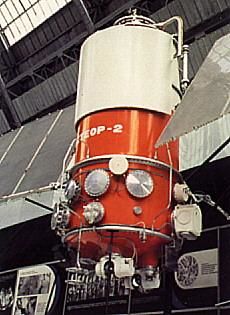 | Meteor-2 |
UNKS was internally reorganized, with the three main KIK Control and Tracking Centers (Yevpatoriya, Yeniseisk, Ula-Ude) designated Central Command Control and Tracking Centers. Five separate trials centers were established (4 at Baikonur and 1 at Plesetsk). Under project 'Rokot' primary and reserve Command Points were established at Golitsino-2 and Znamenka in Tambovsk Oblast. By the end of 1988 the reorganization was completed.
New political reforms were introduced on 1 July 1988 at the 19th Congress of the Communist Party of the Soviet Union. These included decisions on a peace platform, withdrawal from Afghanistan, and rapprochement with the USA. The American reply came within weeks. In October 1988 a revised three-phase SDI program was announced. Phase 1 would involve kinetic kill vehicles ('Brilliant Pebbles'), geosynchronous tracking satellites, and suborbital systems to observe ICBM trajectories. It was to be completed by the year 2000 at a cost of $100 billion. Phase 2 involved space-based platforms with hundreds of kinetic interceptor weapons. Exotic lasers and beam weapons had been relegated to a murky Phase 3.
From 1984 to 1989 $ 25.15 billion was spent on the American SDI, with military space expenditures exceeding those of NASA by 100% in 1988. Funding was reduced after 1988 as the technical difficulty and cost of actually fielding a system was realized. In 1988 only $3.9 billion in funds were received versus $ 5.7 billion requested.
Although in May 1989 work began on 'Phase Zero' of SDI, the US was finding its SDI to be neither technically or economically practical. Even with intercept ranges of 3000 to 5000 km thousands of interceptors would be required. The more modest Brilliant Pebbles system did not come close to meeting the original stated requirements. Soviet studies reached the same conclusion - space was suited for command and control of military forces, but not as an arena for combat.
To support launch of anticipated Soviet anti-ballistic missile forces the MOM Ministry of Medium Machine-Building pushed development of the super-heavy Buran, Buran-T, and Vulkan boosters without proper cause. Needed light and middle class boosters were delayed. The Soviet SDI program, which would have been the only source for payloads for these large boosters, was not financially feasible. This emphasis on these large systems also delayed work on third generation launch systems, which had begun in the 11th Five Year Plan (1981-1985).
1989 was the peak year for Soviet space, with 20% of the state scientific research budget devoted to space technology. In that year the civilian space program of the USA was $29.6 billion versus 6.9 billion rubles in the USSR. The American military space effort was costing $22.8 billion versus 3.9 billion rubles in the USSR, almost 6 times as much. Space economic and scientific programs were budgeted at $ 3 billion in the US versus 1.7 billion in the USSR. Reusable space systems cost $ 3.8 billion in the US versus 1.3 billion rubles in the USSR.
Partly due to the cost of trying to match the American Star Wars program, the Soviet Union disintegrated. Ironically, underground nuclear tests of the x-ray laser in Nevada showed that the concept would not work. Other parts of the colossal Strategic Defense Initiative ran into similar technical and cost barriers.
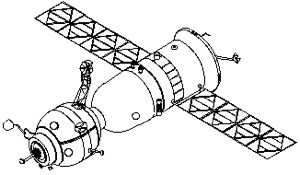 | Soyuz T Credit: © Mark Wade |
The Soviet balance sheet showed that conventional space systems had provided real benefits. Space amounted to 1.5% of the Soviet state budget. It was estimated that use of military satellites increased the effectiveness of military forces by 50% to 100%. In the 30 years since Sputnik the Soviet Union had spent 5.9 billion rubles on civilian space projects, with an estimated economic benefit of 12.6 billion rubles. The Moskva and Ekran television systems reached 93% of the USSR, with an economic benefit of 540 million rubles in 1988. Meteor-2 weather satellites were estimated to have an economic benefit of 500 to 700 million rubles per year. In 1989 it was anticipated that by the year 2000 commercial manufacture of medical and other materials in orbit would reach 20 billion rubles. The Tsikada system provided navigation to 4,500 ships while the Nadezhda COSPAS-SARSAT system had assisted in the saving of over 2,000 lives.
In developing Buran, 100 new materials, 24 new technical processes, 130 novel types of equipment, and 60 novel material types were developed with civilian applications. While the shuttle continued in use in America, in the Soviet Union it was considered part of the answer to SDI, and more a system for the 21st Century.
The US and USSR had achieved a balance of forces in the late 1970's and early 1980's, but then US military circled insisted on development of SDI. But in the Soviet analysis the USSR could have easily prevailed over any ABM system by using from 50% to 100% more missiles than the US.
Third Generation Launch Systems
The aborted third generation systems would finally have replaced the remaining ICBM-derived boosters (Kosmos, Tsiklon, Soyuz, Proton). They would use Lox-Kerosene or Lox-LH2 non-toxic, environmentally 'friendly' propellants to power a modular family of launch vehicles with payload capabilities of from 5 to 100 metric tons to orbit. Three common engines would be used in the all of the stages of all of these designs. It was intended that the lower stages would be evolved into recoverable and reusable versions after initial development. These launch vehicles were:
- Kvant; Four RD-120 engines (from second stage of Zenit) modified for sea level use, Block DM upper stage as designed for Zenit-3. Payload 5 metric tons to low earth orbit
- Zenit-2: One Energia strap-on as the lower stage. RD-120 powered upper stage, 10-12 metric tons to low earth orbit
- Energia-M: Two Energia strap-ons plus reduced Energia core with one RD-0120 engine: 20-30 metric tons to low earth orbit
- Groza: Two Energia strap-ons plus full Energia core with four RD-0120 engines: 40-50 metric tons to low earth orbit
- Energia: Four Energia strap-ons plus full Energia core with four RD-0120 engines: 80-100 metric tons to low earth orbit
Manned systems: Buran had the same characteristics as the US Shuttle, and the same disadvantages - low economy, and mainly designed by construction bureaus for scientific and technical development and human space travel. Therefore design work continued on smaller spaceplanes as a replacement for the Soyuz manned ferry. Numerous trade studies of Russian Spaceplanes in the early 1980's (Bizan, System 49, System 49-M, OK-M, OK-M1, OK-M2) would finally result in the optimized MAKS design. This was approved for full development in 1988.
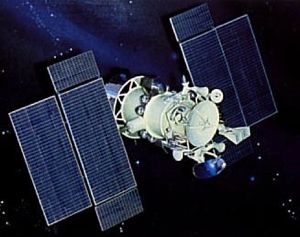 | Gorizont |
Single stage to orbit: In response to US technology initiatives, work on a Soviet counterpart to the American X-30 National Aerospaceplane was started in 1988. Following evaluation of various competing proposals (VKS, Yakovlev MVKS) the Tu-2000 scramjet vehicle was selected for development.
Third Generation Conventional Systems
Continuous Observation Operational Space System
The long term objective of the Soviet Union was to match the capabilities of the American KH-11 digital imaging satellite. The characteristics of this satellite were well known since spy William Kampiles provided the operating manual to the Russians in 1978. Soviet attempts to develop such a system were thwarted by an inadequate technical base. The first attempt was the TGR television satellite of the 1960's. This was succeeded by the Yantar-6KS, cancelled in May 1977 when the draft project indicated that the weight had grown beyond the payload capabilities of the Soyuz booster. A less-capable spacecraft based on the Yantar-4K bus was designed. The first phase spacecraft, the Yantar-4KS1, would begin flight trials in 1979, with the more capable Yantar-4KS2, launched by Zenit, to begin flight trials in 1983.
Development was slow because of the state of Soviet digital electronics technology. Yantar-4KS1 flight trials did not begin until the end of 1982. It proved impossible for the Yantar-4KS2 to match the performance of the KH-11. Therefore a 'clean sheet of paper' approach was taken.
Ustinov consolidated all optical reconnaissance work at TsSKB in 1981-1983, cutting across six ministries (the Ministries of Defense, Medium Machine Building (nuclear weapons), General Machine Building (rocketry), Electronics Industry, Radio Industry, Industry of Communications Means).
Studies were begun in 1980 and in June 1983 a decree was issued for a constellation of new-design third generation electro-optical military reconnaissance satellites. In July 1983 Kozlov was made Chief and General Constructor of the enlarged TsSKB Central Special Design Bureau. Under his leadership a multi-element reconnaissance satellite system was to be developed in 1981-1990 and deployed by 2000. These would be orbited in two groups of ten satellites at varying altitudes. This swarm would provide almost complete coverage of the earth's surface at a range of photographic resolutions.
Competitive designs of the imaging satellite were undertaken by NPO Lavochkin and Kozlov's TsSKB using common universal optic systems. Flight trials were to begin by 1986-1987. The Continuous Observation Operational Space System included a SLAR-equipped radar satellite by NPO Vega, with flight trials set for 1992. The launch vehicle for the third generation satellites was to be the Proton since Zenit did not have the necessary lift and Energia development was delayed. The data would be transmitted to the ground by GKKRS relay satellites.
Work on a new optics system had already begun in 1977 at Lavochkin. Development of the optics was a very difficult task headed by A N Veikozhon at the Leningrad Optical Mechanism Enterprise.
By the beginning of 1989 it became clear that this schedule could not be held. TsSKB had a lot of work on Buran and its associated scientific payloads. The mid-1980's put huge demands on the spacecraft design bureaus. They were attempting to test and put into production third generation systems while at the same time responding to government 'star wars' crash programs. The common telescope for the new generation satellites had weight problems, delaying the start of flight trials.
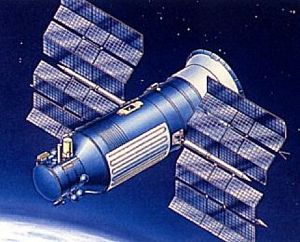 | Gamma |
A single example of the new Lavochkin satellite, the Arkon-1, was finally launched in 1997 into an unusually high orbit for a photo-reconnaissance satellite. This evidently was to take full advantage of the single satellite available, even at the sacrifice of ground resolution.
As a back-up improvements were made throughout the 1980's to the Yantar-4K, providing both high resolution and survey variants. The first flight trials of this new series of 4K's was to begin in 1989, but the satellites were not ready. Finally the work was abandoned.
Naval targeting satellites of the third generation had flight trials scheduled for 1990 in the 1984 plan. This was seriously delayed.
SGKRN System of Global Space Radio Observation
The Tselina-3 third generation ELINT was developed in parallel with Tselina-2. Work began in the 1970's, with research on a variety of new systems. Experimental instruments were flight-tested aboard Tselina-D missions. Two flight tests in 1986-1987 proved the effectiveness of the technical solutions. In 1985 the technical project for an operation system was begun. High orbit tests in 1988 showed the system would have to be deployed in two systems: a constellation of satellites in orbits of 800 to 2000 km altitude; and a Space System for Radio Relay and Combat, consisting of 1 to 2 satellites in geosynchronous orbit. The third generation satellites were designed by NPO Palma of Minradiopribor, with KB Yuzhnoye providing the satellite bus. The geosynchronous satellites, developed from the Luch relay satellites, were by NPO PM MOM. Flight trials of specialized relay payloads for use with the ELINT satellites of the VMF and DOS were tested during two launches in 1989.
YeSSS-3 Communications System
The third generation satellites of the YeSSS-3 communications system were developed by NPO PM. The two phase project would develop an improved version of the Raduga satellite, followed by a completely new design high elliptical orbit satellite to replace Molniya. These satellites would provide real-time operational and technical communications for the command units of the VVS Air Force and Soviet Navy, aboard aircraft, surface ships, and cruisers. The satellites would be equipped with millimeter band multibeam antennae and a greater capability for signal processing aboard the spacecraft. Capacity and survivability would be increased by doubling the number of spacecraft in each constellation.
Work on the third generation high elliptical orbit satellite was completed and the system was accepted into the military in 1987 as the Molniya-1T as part of the RVSN command and control system. The Modernized Ekran-M and Stuk-2 satellites completed flight trials at the same period.
For civilian communications modernized geosynchronous satellites were developed. The Ekspress was to replace Gorizont, and the Gals direct-broadcast satellite was introduced.
The Strela-3 had replaced both earlier models of the series for store-dump communications from the mid-1980's. Commercial versions Gonets-D1 and Gonets were launched but were not successful in attracting investors.
 | Geo-IK |
The modern GLONASS-Uragan system had entered operation during the late 1980's. A total of 22 spacecraft were placed in the constellation by the end of 1987, and 31 by the end of 1989.
Planeta Meteorological System
The system consisted of Meteor-3 sun synchronous satellites complemented by the geostationary Elektro satellites. Work began with a December 1972 resolution of the VPK Military Industrial Commission calling for development of a third generation Meteor satellite to start the following year. The draft project for the Planeta-S was completed in 1979, followed by the detailed design in May 1980. However it was not until 1981 that a resolution called for the Planeta-S unified meteorological system, and development of the system was only fully funded in June 1983. This system was developed at VNIIEM MEP by N Sheremtyevskiy and Yu V Trifonov. The draft project was completed in 1984 by VNIIEM Filial Istriisk under V I Adasko. Tests of some new equipment aboard Meteor-2 flights began at the end of 1984. Flight test of the complete spacecraft from Plesetsk did not start until 1990. Elektro development also ran into enormous obstacles in the period 1983-1987, with a mock-up not begin completed until 1989. Only by then were drawings for a flight article completed.
Support Systems
Development of a Taifun-3 third generation radar calibration - ASAT target spacecraft, derived from the Taifun-2, went well. The target was also used to exercise the A-135 ABM complex of the PVO and provided a system of wide-spectrum signal impulses. KB Yuzhnoye launched the first spacecraft of the type from Plesetsk in 1988. The satellite was launched by the Tsyklon 3 launch vehicle and released 36 Romb subsatellites.
Manned Program
The Mir-2 space station was to have utilized the capabilities of the Buran orbiter and Zarya and Progress M2 resupply spacecraft. After the decision for the crash 'star wars' programmer the primary mission of the station became that of a weapons test platform. This involved competitive proposals from Chelomei Mir-2 KB Salyut and Energia (Mir-2). It would undergo many changes over the years, with only one thing remaining constant: the starting point was always the DOS-8 base block space station core module, built as a back-up to Mir's DOS-7. Eventually Mir-2 would be merged with the International Space Station, and DOS-8 was finally launched as the ISS Zvezda Module of the ISS International Space Station. The planned Mir-Buran docking module entered service on joint American-Russian missions as the Mir-Shuttle Docking Module. A variant of the TKS was purchased by the Americans and, as the ISS Zarya, became the first part of the ISS orbited.
Scientific Satellites
- Launch of AUOS bus scientific satellites continued. On 28 September 1989, AUOS-Z-IE Aktivniy studied the magnetosphere and electron plasma. On 18 December 1985 AUOS-Z-IE Ionozond studied electron concentrations and the ionosphere.
- The Granat orbital X-ray - gamma-ray observatory was developed jointly by the USSR with France, Denmark and Bulgaria.
- Planetary launches dropped off significantly with only two failed Fobos 1F missions in the last years of the Soviet Union.
- Resurs-F satellites continued in use and comprehensively mapped Chukotka, Novaya Zemlya, the Kuriles, middle Asia, the Pamirs, and Tian-Shan. The Cosmos 2000 mission surveyed the Antarctic. The annual economic benefit in 1989 of such missions was estimated to be 30 million rubles.

Glonass -
Okean-O satellites continued to monitor the world ocean, including the polar regions. Data received by ships aided them in conducting operations. The satellites returned data on weather states, biological tracking, and temperature anomalies. They were equipped with a side-scanning radar and the SVCh scanning radiometer. The satellites also mapped the Arctic and Antarctic, and obtain data on lakes and rivers (including the Okhotsk and Amur).
- Foton continued in use for material processing experiments that took advantage of the zero-gravity high-vacuum environment of space.
- In 1986 TsKBM proceeded with study of the earth's surface using the Almaz-T satellite. But it was not used for military purposes since the Ministry of Defense was satisfied with the performance of its new electro-optical satellites. Finally the Academy of Sciences agreed to take it over and use it on a science mission. Cosmos 1870 was successful and functioned for two years. A commercial version with 15 m resolution was launched in March 1991.
- In March 1988 the Soviet Union conducted its first commercial launch. An Indian earth resources satellite was placed in orbit for a fee of $ 7.5 million. This was the first of many -- commercial launch services would become a primary money-maker for the Russian Federation in the 1990's.
Russian Federation Space Systems
The 13th and last Five Year Plan (1991-1995) saw vast changes brought about by the collapse of the Soviet Union. The space forces had been reorganized in November 1988, but despite collapse of salary and budget deliveries work under the 12th Five Year Plan was completed. Most noticeably flight trials of Tselina-2 were completed and the system was accepted into the military. Flight trials of Strela-3, Molniya-1T, and Meteor-3 were conducted. Research with Resurs-F2 resources satellite and the Taifun-3 target complex went ahead, together with deployment of 40 new control systems.
Although ground tests and flight development of third generation systems had begun, there was no capital to meet the schedule established for the 1991-2000 period. Plans for countering SDI had to be abandoned. KIK Tracking stations no longer on Russian territory were abandoned, and to compensate three new tracking stations were built at Eysk, Maloyaroslavets, and Barnaul. With the break-up of the Soviet Union 75% to 90% of the space industry remained in Russia, but some unique capabilities, especially the Proton launch site, were lost.
Not all missions planned could be accomplished, and new priorities included attempts to commercialize space technology. Under the Konversiya concept space industrial facilities were to be converted to civilian use. Attempts were also made to market Soviet space technology internationally.
This was manifested as early as the launch of the Kristall module to Mir on 31 August 1990. The 19.5 metric ton module carried 7 metric tons of materials processing payload and the APAS-89 docking system for use with the US space shuttle. Collaboration with the United States on the ISS International Space Station also pumped funds into Mir. Meteor-TOMS was financed by Germany. In 1990 the Chinese head of state visited Baikonur, leading to space co-operation contracts from China. On 25 February 1992 the RKA Russian Space Agency was founded as a counterpart to the US NASA Agency. Staff involved with civilian space projects were transferred to the new organization. On 7 November 1992 the UNKS was replaced by the UK-VKS - Directorate for Command of the Military Space Forces.
The national space plan in 1992 was as follows:
- Phase 1: By the end of 1992: Complete reorganization of the VKS Military Space Force and its infrastructure
- Phase 2: 1993-1995: Complete test and development of third generations systems; ensure that the interests of Russia in space were met
- Phase 3: 1996-2000: Plan sustainable infrastructure, complete organization of a central directorate for military-space affairs in the military forces of the Russian Federation
 | Yantar E1 Credit: © Carsten Wiedemann |
The Russian space plan identified nearly twenty new satellite communications systems. Networks receiving federal support in addition to commercial financing included Arkos, Ekspress-M, Gals, Gonets, Mayak, Signal, and Yamal. Systems which had to secure complete commercial backing were Bankir, Ekspress, Gals, Gelikon, Globsat, Kondor, Koskon, Kuryer, Nord, Sokol, SPS-Sputnik, and Zerkalo. Of all of these only Ekspress, Mayak, Gals, and Bankir (as Kupon would reach orbit by 2001.
During 1993-1994, 27 launches involving 47 communications satellites were undertaken, or 29% of all Russian space missions. Despite one launch failure, 27 low earth orbit, 7 highly elliptical, and 12 geosynchronous spacecraft were successfully deployed. These numbers represented about half of the operational network (an acceptable 2-year turnover). But some specific constellations became increasingly populated with spacecraft operating beyond their design lifetimes. This situation was especially apparent in geosynchronous orbit. As the 1990's continued ex-Soviet communications satellite constellations would continue to degrade.
In 1996 a concept for national space policy of Russia was issued in a decree. This covered the period to 2005. 4 October was made national VKS Military Space Forces day. The plan was as follows:
- The VKS Military Space Forces as an independent arm of the military forces.
- Russian national Cosmodromes at Plesetsk and Svobodniy.
- Military Training Centers at the A F Mozhaiskiy VIKA and the Petr Veliky Military Space Cadet Academy.
- Three Major Command and Tracking Centers (OKIK).
- Operation of Baikonur in accordance with the Russia-Kazakh treaty for commercial and military launches.
- Consolidate reliable control of spacecraft within Russian territory.
- Complete and publish 13 decrees of the Russian President and 25 of the Congress.
- Accept into military service five new space systems, including three for which flight trials were already under way
- Consolidate and improve housing, hospitals, and build a new Black Sea sanatorium for staff
- Participate in Air Shows: Navigatsiya 92 in Moscow; Le Bourget in 1993-1995; Berlin and Farnborough in 1994; Moscow in 1994-1995
These objectives also proved unrealizable. At best only single articles of some third generation space systems could be launched. Development of Zenit pads at Plesetsk and the Svobodniy cosmodrome stalled for lack of funds.
In a scramble to attract Western investment in the financial crisis that following the break-up of the Soviet Union, many proposals were made in the 1990-1996 period for commercial use of Russian spacecraft. Market realities meant that virtually none of these were realized.
TKS derivatives were offered as earth resources and material processing platforms (Tellura, Teknologia). Military communications systems were proposed for civilian use (Gonets). Many proposals were made that took advantage of the heavy payload capability of the Energia booster. These included Multipurpose Satellite Gals, Energia Control Sat, Energia Geostationary Platform, Globis (Energia Heavy Comsat), Energia Nuclear Waste Disposal, Energia Orbital Debris Remover, Energia Ozone Replenishment Satellite, Energia Polar City Illuminator, and Skif-DM.
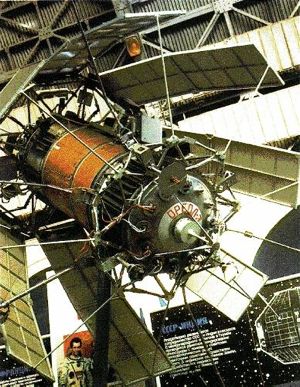 | Oreol-3 Spacecraft using AUOS bus are similar Credit: NASA |
As the 1990's continued military and civilian satellite constellations could not be sustained. Key satellite and rocket components were only made in ex-Soviet states that wanted hard currency or high prices. No budget was available to continue programs. The unpaid workers of the space industry were however able to continue by using reserve rockets and spacecraft plus complete those units that were in the pipeline when the Soviet Union broke apart. Satellite constellations were replenished at a slow rate but kept at a minimally operational status by rearranging existing satellites.
Russian space launches meanwhile ground to a virtual halt. In July 1997 the VKS Space Force was dissolved as a separate service arm and incorporated, together with the anti-ballistic missile arm of the PVO, into the RVSN Strategic Rocket Forces.
The absolute nadir was reached in 1999, when Russia orbited only 16 satellites, one sixth the number in the last year of the Soviet Union. At the same time, lessons learned in the Kosovo conflict clearly showed the importance of space forces in modern warfare.
From this point, under the leadership of President Putin, Russian space began to revive. Launches were conducted in 2000-2001 to finally replenish military satellite constellations and return them to minimum operational levels (Glonass, Molniya-3, Orlets-2, Prognoz SPRN, Raduga-1, Strela-3, Tselina-2, US-PM, Yantar-1KFT, Yantar-4K1 and Yantar-4KS1). Development of the all-Russian Angara modular launch vehicle to finally replace earlier designs and move all Russian launch operations back to Russian territory was revived with new vigor. However funding was insufficient, progress was slow. The first Angara launch from Plesetsk only came in 2014, and Soyuz rocket launches from the new Vostochny/Svobodniy cosmodrome only began in 2016. Meanwhile the venerable Soyuz provided the world's only access to the International Space Station after the retirement of the American space shuttle in 2011. Numerous designs for a manned spacecraft to replace the Soyuz were announced but development was never funded.
As Russia entered the new millennium it was following a strategy of using existing military space systems to retain a minimum essential military space capability. Slow development of the Angara launch vehicle continued to be funded through successful commercial sales of Proton launch services and Zenit rocket engines. Secrecy in regard to new military satellite development was reimposed. The dim outlines of a modernized, lightweight, and more appropriate Russian space capability for the 2010's was emerging.
Soviet Space System Development Process
The concepts and plans for the first generation of Soviet spacecraft came from the visionary chief designers themselves - Korolev and Chelomei. During the course of the 1960's a more orderly process of specifying, developing, and deploying space systems was put into place. This was largely derived from established processes for aircraft and other military products.
The following describes the 'official' orderly process as it was supposed to be practiced. As was the case in the United States this process could be short-circuited by powerful Chief Designers, Generals, or Politicians. But to a large degree the space systems that went into production for use by the Soviet military followed this procedure.
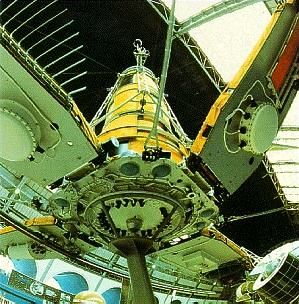 | Okean-O1 Okean-OE was similar. Credit: NASA |
Once the final plan was approved, it would be formalized in a decree of the Communist Party Central Committee and the Supreme Council of Government Ministers. The planning process had already generated a TTZ, or tactical-technical requirements document, for each new system. This specification included:
- Purposes and requirements of the spacecraft, launch vehicle, or system
- Fundamental characteristics, including required equipment
- Required flight plan, including orbital parameters
- Required minimum equipment and interfaces. This includes definition of the number and interval of control and command communications sessions, required telemetry parameters, orientation/stabilization requirements, thermal requirements
- Conditions on use of the system and its components
- Required documentation and deliverable data items
- Number and types of systems required for development and flight trials
The government decree provided the permission for the design bureaus to expend the internal funds necessary to create the draft project document (equivalent to use of Bidding, Proposal, Industrial Research and Development budget pools of US government contractors). Selection of a design bureau, and the decision whether to even proceed with development of the system, would only be made after submission of the draft projects. The steps involved in creating a draft project:
- Estimate of spacecraft mass and dimensions, leading to selection of an appropriate launch vehicle
- Financial and schedule estimates for the development program
- Preliminary specification for on-board equipment
- Identification of applicable technical standards and standard equipment already meeting needs
- Communication with other design bureaus (launch vehicle, spacecraft, subsystems, propulsion) to establish contact points and set up teams
- Specification compliance matrix
- In parallel with these steps, review of current and previous applicable development projects, patent searches, maximum use of already-completed development.
Step 1: Advanced Project or Technical Proposal. This contained:
- Brief overall description of the spacecraft
- Functional process diagrams
- Selected general layout and/or presentation of variants as indicated by trade-off study
- Technical specification of subsystems and on-board equipment
- Completion of theoretical and experimental risk-reduction research
- Firm estimate of required development effort
- Analysis of required unique or new-development equipment
- Estimate of technical and economic resources required for development
- General arrangement drawings of the spacecraft
- Development test plan for qualification of systems and propulsion
Step 2: Draft Project. This was the document submitted to the customer. It contained:
- Proposed detailed component layout, flight plan, system and subsystem specification
- Systematic analysis of spacecraft reliability
- Development, qualification, and flight test program
- Recommended flight test program
- Failure modes analysis
- Proposed production documentation
- Specification compliance matrix
In Soviet practice the draft project of each design bureau would be 'defended' in person, much as an academic dissertation might be defended, to a government commission consisting not only of customer representatives but the competing chief designers as well. Depending on the results of the review, as well as inevitable budget battles and politicking, one institute would be selected to proceed with development of the system (in at least one famous case - the RS-17 and RS-19 ICBM's - the leadership utterly deadlocked on the selection, resulting in two major systems meeting the same TTZ being developed and put into production).
If the decision was made to proceed, this would be formalized in another government decree. Typical steps in systems development included:
- Development of documentation required for production
- Drawing release for production of the complete article
- Documentation required to build factory and development test fixtures, tooling, and test equipment
- Electrical drawings for factory and test equipment
- Flight test documentation
- Post-flight analysis and corrective action
- Development tests, limited to but not including:
- Mechanical and systems test stands
- Static test
- Dynamic test
- Thermal test
- Parachute and recovery tests on land and sea
- Solar panel test
- Electric system test
Soviet Space Quality Assurance
Spacecraft Quality Assurance
The 16 February 1961 decree 'On measures to improve military technology' laid the basis for institution of quality control by the military to improve the reliability of space systems. Prior to this the quality of space systems was assured primarily through the efforts of the Chief Designers - Korolev personally supervised shop work for the first Sputniks and cherry-picked the best components for the Vostok manned spacecraft.
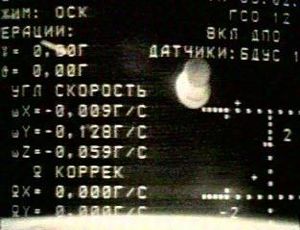 | Raduga capsule Raduga capsule jettison from Progress Credit: RKK Energia |
The steering committee Position RK-75 was founded on 1 July 1975, including Afanasyev, Karass, and Keldysh. RK-75 abolished the positions Zenit-2 and Zenit-4 confirmed by the VPK in 1965 and Position P and PRKK confirmed in 1969. Position 75 was authorized to consider:
This work continued until 1988 when Position 88 was formed. The group issued OTT-75 (Common Technical Specification), which replaced OTT-70. NA-76 revised the organization of the AN Academy of Sciences, the MO Ministry of Defense, the construction bureaus, and TsNIIMASH. Standard documents were promulgated for environmental and electromagnetic specifications for equipment. Specifications for satellites were Moroz-2 (1962), Moroz-3 (1968), and Moroz-5 (1976). These set forth reliability factors and trials requirements. By 1976 satellites were required to have a three to five year operational life. The groups sponsored development work on statistical reliability methods.
Launch Vehicle Reliability
At the beginning of the 1970's Soviet launch vehicle reliability was 89.4% compared to 84.3% in the USA. During the 1970's, intensive work improved booster reliability to 92.4% in the USSR versus 91.5% in the USA. There were many reasons for failures: design defects, development problems, materials used, assembly, etc. All had to be tackled. However technical politics blocked many improvements.
The first QA System was the Zero Defect Completion System, BIP, and was developed in 1953 to 1955 at Saratov for IRBM development. In 1957-1958 the KANARSPI "Quality, Reliability, Resources in First Article' system was developed at Gorkiy and applied in Moscow, Yaroslavl, Kasmatorsk, Tashkent, and Lvov. An August 1975 decree established new complex quality assurance systems, and these were implemented by the end of 1975 by the MO. The system was developed by the NII of Technology for Factories and TsNIIMASH for application to design bureaus and research institutes. This was the KSYKP - Quality Controls for Complex Problems, which addressed quality assurance throughout the life cycle of the end product.
The standard OST 92-0200-72 Quality Assurance System (SOBT) covered development and production phases. This was part of SMPKT - System for Increased Quality Assurance.
From 1968 standardization of development documentation according to state standards was imposed. PN-76 was the sub-unit for reliability engineering. By 1976 launch vehicle reliability was 95.1% and space systems had high levels of availability, resulting in reduced spares and reserve satellites.
Soviet Space Tracking Systems
On 30 January 1956 work began on a satellite for military purposes. A KIK control system was under development for control of the first satellite. But the military raised the issue: how were they to be controlled without the use of military control points? Zhukov became personally involved. The requirements were fantastic for the period: a communications net of widely flung (separated by 1,000's of kilometers) radar, tracking, and command stations, all in instantaneous encrypted un-interceptable communication with one another. In fact, such a system had already been developed for the PVO for air defense and interceptor control. All necessary units were available, with minor modification. Therefore the General Staff instructions were to use Red Army communications for interconnection of stations.
 | Polyus Combat Sat Cutaway of the Polyus 1 space weapons platform. Credit: © Mark Wade |
- STK-1 Don
- STK-2 Neva
- Indikator T
- Tral
- RTS-2
- RTS-3
- RTS-7
- Indikator-D
- RUP
- Fakel-D
- Binokl-D
- Irtish-D
- KT-50 cine theodolite
- KT-80 cine-telescope
Assisting in launch tracking were:
This combination of PVO and ICBM tracking systems made up the network. Trajectory information was fed into the center for orbital calculations. The center was staffed by 680 officers and 151 civilian scientists of the Soviet Army in four sections.
Lunar and interplanetary programs brought new tracking requirements. IP-14 in Shchelkovo was first upgraded for the lunar program with the Kama-E distance measuring system. IP-41E (Simeyz) and IP-42E (Moscow) later received the same upgrade. NIP-16 at Yevpatoriya was equipped to handle interplanetary probes. The Pluton system sent commands to the probe, while the Saturn system received data. Saturn complexes were built at NIP-3, 4, 14, and 15. This consisted of a 16 m antennae with a 100 million km range. The RS-10-2M antenna was used, plus at NIP-10 the TNA-400. The Pluton Command-Tracking System was installed only at NIP-16.
Development of the Tracking and Control System
The basis for the modernized system was the draft project for a universal command-tracking complex for military space systems. By 1966 nine systems were operated in the KIK. The control center had 18 military units with 6,936 staff, including 1,176 officers and 770 employees. Specializations were created in the second half of the 1960's with the KIS (Command-Tracking Systems). The first system in operation was the Zenit control system. This used the cm-band 'Taiga' radio link (developed by NII-30 GKRE), the Orbital Radio Control Station (RKO) 'Kama E', and the Command-Programming Link 'Podsenzhenik', which used pulse commands in the cm band (developed by NII-10 MSP, Chief Designer M P Petelin).
For the smaller DS satellites, redundant tracking systems 'Vympel' and 'Krab' were developed by NII-648 at the beginning of the 1970's. 'Krab' was used for telemetry, but was replaced in 1965 by the 'Post-2D' radio link and 'Korall' tracking stations at both Baikonur and Plesetsk.
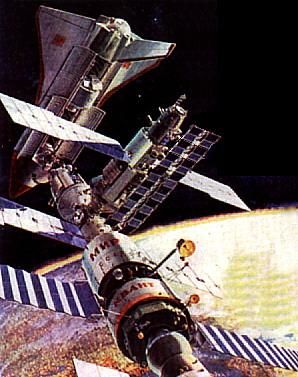 | Buran docks to Mir As it was supposed to be - Buran docking with Mir space station. |
Two new tracking station, NIP-17 Yakutsk, and NIP-18 Vorkuta, were established the same year. They were equipped with KIS Kama, Podzenzhnik, Kub, Krab, and Korall systems.
Encrypted radio channels for Podsnezhnik and Kub were introduced in 1967; they were called Veter and Shtorm.
NII-885 built the modernized telemetry system RTS-8 using phased impulse techniques, greater tracking accuracy, and a greater period of data download. It was a 56 channel system with an accuracy of measured parameters of 1%. The Tral system used by the first Sputniks was replaced by the RTS-8.
Eventually a KIS for interplanetary control was improved during the course of the lunar program from 1966. KIS Saturn was modernized to Saturn-M at NIP-3, 6, 14, 15, 16, and 23.
5-NIIP-MO used complexes Foton, Mezon, and Kreon for sending commanding, receiving telemetry, photography, television, and ranging. NIP-15 was the center for long-range tracking.
Tracking equipment in 1958 consisted of the T3 4 MI MO OKB. The Leningrad Polytechnic Institute developed the Pozul-Kvartz system. Trajectory data was obtained from RTS Binokl-D and Kama-E, which was transmitted to the center for analysis by telegraphic communications.
PUVD was the computing device used at the center for ballistic tracking and modelling at 4 NII-MO. It was replaced by the UTS 4 from 1968.
In 1960 OKB LPI began serious development of a second generation system, Temp, which entered service in 1971. OKB Impuls built the multiple parameter RTS Bufer-1M, which was installed at all NIP's in the 1970's.
Airborne tracking aircraft (SIP) and airborne tracking/control aircraft (SKIP) began in 1958 with 10 Il-20RT and 6 aircraft-antenna analogues Il-18I. These were under control of GUKOS (Chief Directorate of the Space Forces of the Ministry of Defense). In 1974 after military trials they were taken into the 94th Squadron of the Military Transport Regiment of 5-NIIP. They were combined with military units at the end of the 1980's for morale/resource reasons. These aircraft were used to solve tracking problems in the Far North, Far East, Central Asia, European Soviet Union, and Afghanistan. They were crucial in refining orbital measurements to determine corrective maneuvers.
The Centre, KIK, by 1970, consisted of 23 units, 19,955 military staff, including 4,080 officers and 3,540 civilian employees. By this time the whole military apparatus for satellite control was being institutionalized: engineer specializations created, documentation created, etc. At the end of Eighth Five Year Plan there were seven new satellites, and 10 satellites and 8 launch vehicles were in series production.
KIK Development
New telemetry systems were introduced in the 1970's: Tral-K2N, RTS-9.
In 1972 the Saturn-NS program was begun to better integrate and modernize the system consisting of: communication lines Korall, Kub, Basa; orbital control stations Krab-U, Izumrud; processing apparatus Podshezhnik, Veter-3N, and stations Kub-U, Korall-U, Kuch-U, equipped with SKAT. New telemetry station MA-9MKTM. Trials begun of new autonomous units, especially for naval deployments. In 1972, via KIK 120,000 communications sessions and 42,000 control sessions were conducted, three times more than in 1967. From 1973 the Third Military School of Junior Specialists was formed to eliminate the deficit in training staff.
In 1962 Command Centre KIK Andrei Grigorevich Karass began work on autonomous relay of data to the center. In 1966 the decree was issued for development of the Skat system. It was developed by NII-5, the Moscow Scientific Research Institute for Scientific Devices. The system could autonomously deliver processed data to the center and five peripheral points. At the first stage of the project three types of satellites could be controlled, up to 150 separate satellites at time.
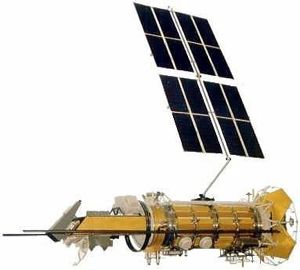 | Okean-O Okean-O2 satellite. The Tselina-2 and -3 SIGINT satellites are believed to use the same vertically-stacked satellite bus and to be similar in appearance. Credit: Dmitry Pieson |
The TsAK common system allowed control of satellite systems from: Staff and political units; central command points; three control/administration stations. The Skat control system incorporated ballistic tracking sections; planning, co-ordination, and analysis sections; and materiel and finance units. Control of a satellite consisted of the following steps: ballistic tracking, telemetry control, satellite system status and health analysis, formulation of the control program, upload of the program to the satellite, execution of the program by the satellite. The system allowed professional operations control on a regular cycle, with individual satellite operations at planned intervals. The only exception was control of manned flights, which were done by a special separate system.
Communications of the first generation (1954-1972) were based on telephone and telegraph channels, using hand commutators and vacuum tube apparatus in radio communications control units. In February 1961 the Beluga communication junction was put into use. In 1967-1972 military control points and standard communications were integrated into common communications junctions such as Golitsino-2 at Shabolovka, in Moscow. Region communications junctions were also used for control of lunar spacecraft, such as NIP-10 and NIP-16. In 1974 -1975 new systems were introduced: Gvardeyets and Kripton. Skat replaced all of these from 1975. From 1970 Bumerang system relayed tracking data between MO tracking centers and the Academy of Sciences.
For cosmonaut communications the Signal system was developed for NI-KIK, telegraphic communications channels, command centers, the ministry of Communications, KGB, and MO. The first generation Zarya communications system for cosmonauts aboard Vostok was developed in 1960. The second generation Aurora system was developed for Soyuz/Salyut and was in operation from 1970. It allowed simultaneous communications between two spacecraft and ground control. It was used from 1976-1976 at NIP-KIK, and IP-1 at 5 NIIP MO. It was also installed in naval tracking ships.
NIP-4, 5, 14, and 15 were equipped for communications with Gorizont-K geosynchronous satellites. The automatic communication systems and for naval units Rumb-M and Gorizont-KB. After 1975 tests of a modernized system at Goltsino and NIP-16, equipped to relay television and telemetry via Molniya-1 satellites.
The first space television was aboard Vostok (Seliger-Tral 1 by OKB MEI, A F Bogomolov). The slightly modernized system was referred to as Topaz, then a second generation system was introduced from 1975. This was the Krechet, developed by VNII-30, A F Polushkin. It incorporated docking views, overlay of docking data, etc.
 | Meteor Meteor satellite. Meteor-M and Meteor-Priroda were similar. |
The number of different equipment types at the KIK tracking stations rose from 85 to 90 in the 1970's to 150 in the 1980's. A program was instigated at the Centre under Lt-Gen N F Shlykov to improve the automation, reliability, and to rationalize the equipment base. In 1979 the P-2500 long range communications antennae was put into operation at Yevpatoriya in the Crimea. The 70 m diameter dish weighed 4920 metric tons and used the Kvant radio-technical system for its operation. By this time the ground-based tracking stations were supplemented by 11 tracking ships, each of which was on station for 7 to 8 months per year.
Meanwhile equipment and facilities at Golitsyno-2 were upgraded as well. Three M-600 computers operating at 1.5 million operations per second were installed at the center, while the tracking stations used M-220 computers operating at 40,000 operations per second. 1976 to 1977 saw the development of the ASU improved automatic control system, which entered operation in 1978. During the 11th and 12th Five Year Plans (1981-1990) 140 million rubles was spent on upgrading Goitsyno-2 Centre, of which half went for non-technical facilities (housing, entertainment, and recreation). Much of this went into the 'Object 413' military city. The population of Golitsyno itself rose from 5,000 in January 1976 to 10,000 by the end of 1981.
At this time the communications network was handling 134,000-136,000 satellite communications sessions per year. Backup tracking stations were formed form 1982. These were comprehensively equipped with control equipment, telemetry receivers, and ballistic tracking sensors. Five reserve points and one backup center were established in total.
Beginning in 1981 systems entered service of automatic control of satellites. Over the following 18 years the KIK stations received new generations of equipment, microprocessor-controlled, with new displays and ELINT receivers. These included the control tracking systems Kub-Kontur and Taman-Baza. In the first half of the 1980's new systems were delivered with better navigation parameters. The KOS quantum-optical system used lasers and telescopes and functioned together with the Taman-Baza equipment. One such complex was established at Maidanak at 2600 km altitude in the Pamir Mountains. The station was built by NII Radiopribor under L I Gusev. From 1979 this served as a Command KIK point as well as conducting scientific research with improved living areas for increased staff and military units. The improved Romashka radio telemetry system provided higher power and four times the range of earlier systems. Modifications to the KIK's were also necessary to handle Buran and communications via the Luch relay satellites.
In May 1977 NTS GUKOS developed a solution for mobile command-tracking posts. The military aspects were developed by 50 TsNII KS and NIR Sluchay and Adapter. In 15 February 1979 the RVSN issued the technical specifications of a Mobile Overland Command and Tracking System (PN KIP), code named Fazan. Full development was ordered on 29 August 1980 followed by a VPK resolution for limited operation on 17 January 1985. The first system was tested during the mid-1980's, based at NIIP-19. Improved tracking ships were also fielded in this period - the Marshal Nedelin in 1982 and Marshal Krilov in 1986.
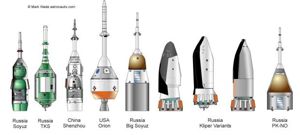 | New Generation Launch Escape Systems of New Generation Manned Spacecraft Credit: © Mark Wade |
Following break-up of the Soviet Union KIK Tracking stations no longer on Russian territory were abandoned, and to compensate three new tracking stations were built at Eysk, Maloyaroslavets, and Barnaul.
| Russia: Soviet Space History at a Glance |
| Russia - Early Ballistic Missiles The true configuration of the world's first ICBM, the R-7, was revealed only in 1967, ten years after its first test. The Soviet N1 moon rocket was only revealed in 1990, 21 years after its first launch. At the same time, other Russian ballistic missiles were routinely paraded before the cameras of the world press even before they went into service. The extraordinary sensitivity of the Soviet leadership over these Korolev designs may be traced to the fact that they derived from the work of the Groettrup German rocket engineering team. |
| Russian Strategic Cruise Missiles As in America, in the 1946 assessments of German military technology, the technical problems of the intercontinental ballistic missile seemed far less than a high-speed cruise missile for the same mission. The Soviet Union developed several such missiles, counterparts to the American Navaho. As in America, it turned out that the ICBM was ready before the cruise missiles were - the navigation and propulsion issues of Mach 3 intercontinental flight were much more difficult than those for Mach 22 ballistic flight. As in America, the projects were cancelled, although they contributed greatly to the national technological base. |
| Russian Rocketplanes The story of rocketplanes and spaceplanes in the Soviet Union was one of constant setbacks due to internal politics, constant struggle with little result. |
| Russian SAMs and ABMs Perhaps no missiles ever produced had as much historical influence as the surface-to-air missiles of the Soviet Union. Originally conceived to provide a defense against the American bomber fleets of the early Cold War, they decisively affected the turn of events when they shot down American U-2 reconnaissance aircraft over Russia and Cuba. Soviet-provided missiles accounted for a hundred American aircraft over North Vietnam and set the terms of the air battle. A new generation of missiles presented a huge technological surprise and took an awful toll of Israeli aircraft in the 1973 war. To this day, Russian surface-to-air missiles provide the only defense available to most countries against American bombers, and Russian man-portable anti-aircraft missiles are a major part of the terrorist threat. |
| Soviet Conquest from Space The story of Soviet space stations in Earth orbit - Korolev's star wars of 1963! |
| Russia: Soviet Manned Lunar Projects The failed Soviet lunar program, and the follow-on lunar base projects that came to nothing. |
| Russian Mars Expeditions Aelita was the Queen of Mars in the famous socialist parable filmed by Jakov Protazanov in 1924. It was altogether fitting that her name would be given to the leading Soviet plan for the conquest of the Red Planet. The Soviet Union's Korolev had the same original dream as Wernher von Braun - a manned expedition to Mars. In both cases this goal was interrupted by the 'side show' of the moon race of the 1960's. In both cases that race proved so costly and of so little public interest that political support for any Mars expeditions evaporated. |
| Russia: Key Meetings in Soviet Spaceflight The key meetings, the main decisions that led to the Soviet loss of the moon race and shuttle race. |
| Russian Designations Designations of Russian ballistic missiles, launch vehicles, and spacecraft. |
| Russia: Location of Russian Manned Spacecraft Where you can see flown and unflown Russian manned spacecraft... |
Spacecraft: Aist, Bars, Bion-M, BLITS , Chibis-M, DX 1, Ekspress-1000, Ekspress-2000, Kanopus, MKA-FKI, Navigator bus, Persona, Relek, SKRL, Sterkh, Sumbandila , Tabletsat Aurora, Tatyana, UGATUSAT , Yubeleiniy, Vostok, Oscar, Meteor, Orlan, Strela-1M, Strela-2M, Tselina-D, Molniya-2, Oko, Bion, Raduga, Taifun-1, Molniya-3, Parus, Meteor-2, Prognoz SPRN, Molniya-1T, Taifun-2, AUOS, Tsikada, Radio, Gorizont, Yantar-4K1, Taifun-1Yu, HS 376, Geo-IK, Yantar-1KFT, Potok, Nadezhda, Glonass, Yantar-4KS1, Zenit-8, Tselina-2, Meteor-3, Strela-3, ISS, Foton, Resurs-O1, Luch, Mir, Soyuz TM, Okean-O1, Orlets-2, Ekran-M, Resurs F2, Resurs F1-14F43, Fobos 1F, Buran, Pion, FS-1300, Raduga-1, Orlets-1, Progress M, Kristall, Mak, Gonets-D1, Znamya, Start satellite, US-PU, Gals, Elektro, Mars Together, Resurs-Spektr, EKA, Spektr, Prognoz-M, Mir-Shuttle Docking Module, Skipper, Priroda, Mars M1, Zeya, Arkon-1, PS Model, Kupon, Resurs F1M, Kondor, Okean-O, Yamal, LMI, Progress M1, IRDT, Simsat, ISS Zvezda, Rubin, Progress M-SO, Kompas, Meteor-3M, Reflektor, Kolibri, Soyuz TMA, Cubesat, Monitor, Larets, Universitetskiy, Spacebus 4000, Nanosputnik, Eurostar 3000, Yakhta, Meridian, Meteor-M, Garpun. Launch Vehicles: Tsiolkovskiy launch vehicle, GIRD, 210 missile series, Katyusha, D-1, RDD, Baranov SAM, Ivanov, Groettrup, R-3, Keldysh Bomber, V-2, Schmetterling, S-25, V-1, Krug, MKR, Taifun, Wasserfall, R-7, R-12, R-5, R-11, Dal, Buran M, RS, R-8, M-100, Burya La-350, KR, Mars tactical rocket, R-15, Tu-130, Tu-123, V-1000, S-75, N1, RT-2, R-13, Luna-M tactical rocket series, YaRD ICBM, Temp, R-21, GR-1, Proton, Luna tactical rocket series, Luna missile, M-51, R-20, R-10, S-200, S-300, Tu-131, Tu-121, Tu-133, Gnom, R-9, MR, 8K79, R-14, 8K711, D-6, Filin, MBR, P-100, P-205, R-500, RT-15, A-35, Spiral, MR-12, P-6, R-38, UR-700, UR-200, RT-25, UR-100, Temp-S tactical missile series, R-27, RT-20, RT-21, V-825, UR-900, R-29, UR-700M, MMR-06, RT-22, Tochka, Pioner, Antey-2500, UR-100N, Temp-2S, S-225, Kub, RLA, R-31, Buran, Oka, System 49, R-39, A-135, S-400, S-300V, Scud, MAKS, Topol, VKS, Skorost, Meteorit, Albatros ICBM, P-750, RSS-40, MERA, Burlak, VVS 1993, Angara, Riksha, Orel, MiG-31NS, Sodruzhestvo, S-500, RS-24. Projects: Anik, BONUM, EORSAT, Intercosmos, Mars, Molniya, Okean, Orlets, Resurs, Strela, Tselina. Launch Sites: Akhtopol, Sverdlovsk, Urda, Vorkuta Sovetskiy, Peenemuende, Wallops Island, Kapustin Yar, Baikonur, White Sea Launch Area, Akita, Kheysa, Plesetsk, Sary Shagan, Chelkar, Black Sea Launch Area, Makat, Novaya Zemlya, Kola Peninsula Launch Area, Kerguelen, Thumba, Barents Sea Launch Area, Kartaly, Nenoksa, Koroni, Emba, Molodezhnaya, Okhotsk, Tatishchevo, Zingst. Agency: FKA, KHRU, RGMS, UNRV, ILS, NASA, MVS, RVSN, AN, PKO, VMF, MO.
 | Sputnik 1 Credit: © Mark Wade |
 | Sputnik 3 Credit: © Mark Wade |
 | Luna 1 / E-1 Credit: NASA |
 | PKA Isometric PKA Isometric drawing Credit: © Mark Wade |
 | VKA-23 1959 design Credit: © Mark Wade |
 | VKA-23 1960 design Credit: © Mark Wade |
 | Vostok 1KP Vostok 1KP Energia Museum Credit: © Mark Wade |
 | Vostok spacecraft Vostok spacecraft view 1 Credit: © Mark Wade |
 | Venera 1 Credit: NASA |
 | Elektron-B Credit: © Mark Wade |
 | Molniya-1 Credit: © Mark Wade |
 | Soyuz PPK Soyuz PPK antisatellite interceptor (conceptual drawing based on description). Credit: © Mark Wade |
 | Kosmoplan - Mars Kosmoplan - Mars reconnaissance version Credit: © Mark Wade |
 | ASAT IS-A Credit: Videokosmos |
 | Soyuz VI Soyuz VI. Forward view showing Soyuz descent module located ahead of cylindrical orbital work compartment. |
 | US-A Credit: © Mark Wade |
 | Oreol |
 | Foton Foton satellite in its assembly hall, with its booster and payload shroud. The cylindrical module at the top is a Nauka module. |
 | Istrebitel Sputnik IS-A Antisatellite satellite. As far as is known, follow-on models and the R-36-launched targets had a similar appearance. Credit: © Mark Wade |
 | Luna 17 |
 | Fwd view of Energia Forward view of Energia launch vehicle in assembly hall at MIK Credit: © Mark Wade |
 | Lunokhod 1 / Ye-8-LS Mature First Generation Soviet Space Systems Credit: © Mark Wade |
 | Strela-1 Strela-1 prototype. Later spacecraft in the series are believed to be similar in appearance. |
 | US-P Credit: © Mark Wade |
 | DLB Module Deployed View of the DLB Soviet lunar base modules as they would appear deployed on the lunar surface. |
 | Prognoz |
 | Yantar-2K Cutaway Credit: Dmitry Pieson |
 | Soyuz VI / OIS Mishin's version of Soyuz VI with OIS light space station (conceptual drawing based on description). Credit: © Mark Wade |
 | Aryabhata Credit: ISRC |
 | Fram |
 | Ekran Credit: © Mark Wade |
 | Tsikada |
 | TKS Manned Ferry TKS manned space station ferry. Credit: © Mark Wade |
 | Progress View of the original Progress spacecraft, as displayed in Moscow in 1981. Credit: © Mark Wade |
 | Meteor-2 |
 | Soyuz T Credit: © Mark Wade |
 | Gorizont |
 | Gamma |
 | Geo-IK |
 | Glonass |
 | Yantar E1 Credit: © Carsten Wiedemann |
 | Oreol-3 Spacecraft using AUOS bus are similar Credit: NASA |
 | Okean-O1 Okean-OE was similar. Credit: NASA |
 | Raduga capsule Raduga capsule jettison from Progress Credit: RKK Energia |
 | Polyus Combat Sat Cutaway of the Polyus 1 space weapons platform. Credit: © Mark Wade |
 | Buran docks to Mir As it was supposed to be - Buran docking with Mir space station. |
 | Okean-O Okean-O2 satellite. The Tselina-2 and -3 SIGINT satellites are believed to use the same vertically-stacked satellite bus and to be similar in appearance. Credit: Dmitry Pieson |
 | Meteor Meteor satellite. Meteor-M and Meteor-Priroda were similar. |
 | New Generation Launch Escape Systems of New Generation Manned Spacecraft Credit: © Mark Wade |
Back to top of page
Home - Search - Browse - Alphabetic Index: 0- 1- 2- 3- 4- 5- 6- 7- 8- 9
A- B- C- D- E- F- G- H- I- J- K- L- M- N- O- P- Q- R- S- T- U- V- W- X- Y- Z
© 1997-2019 Mark Wade - Contact
© / Conditions for Use

